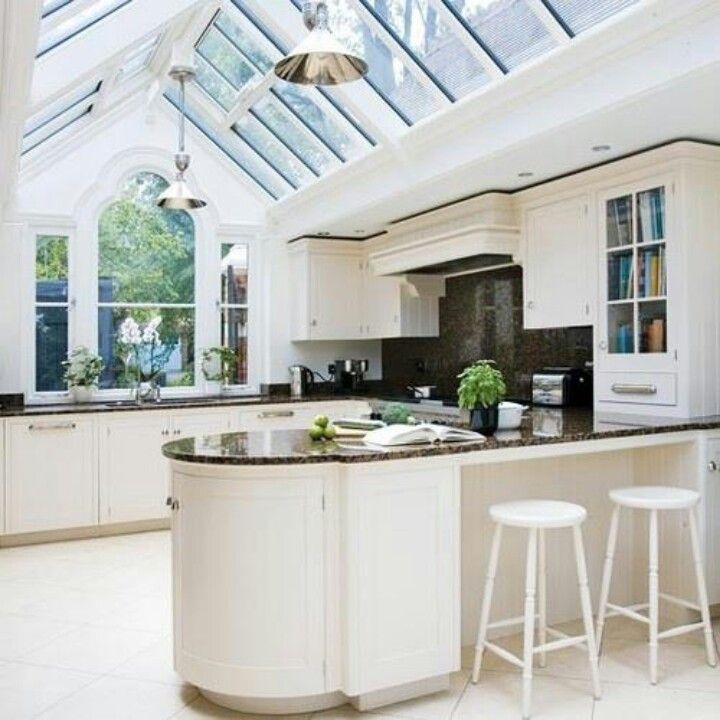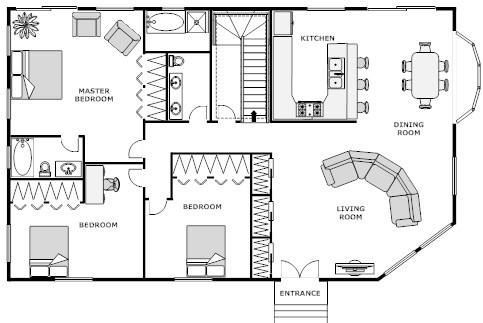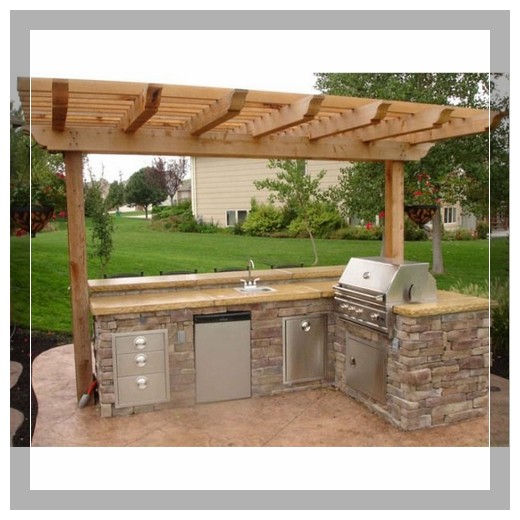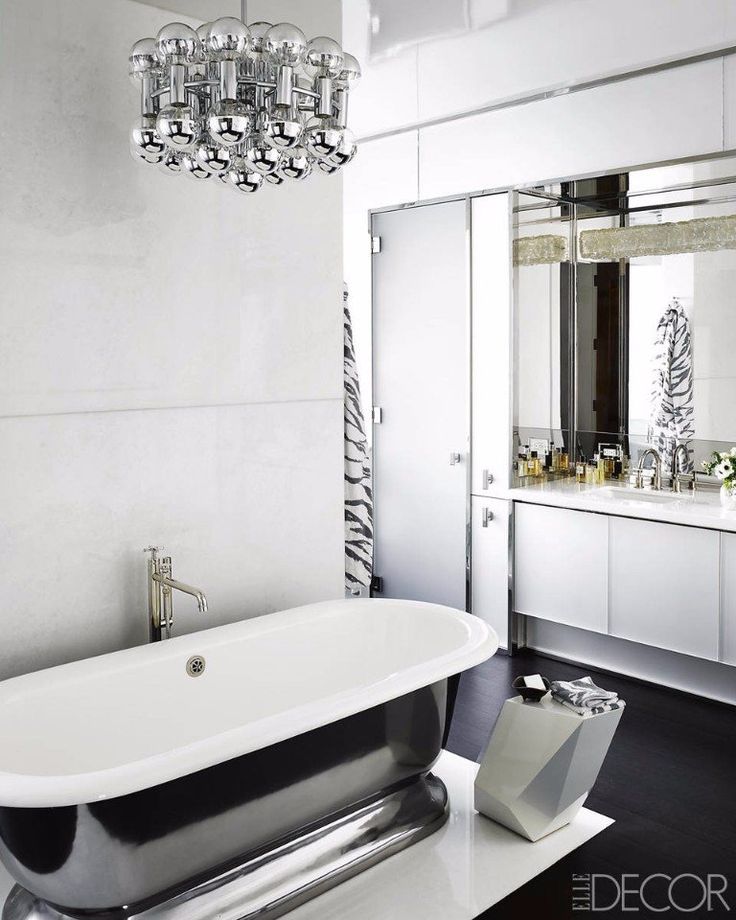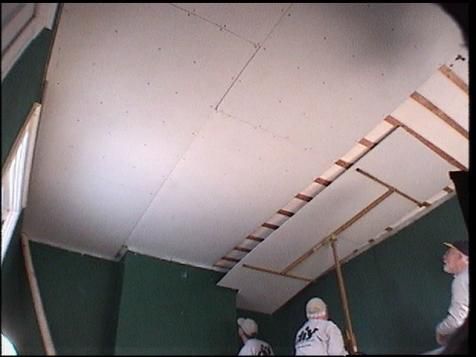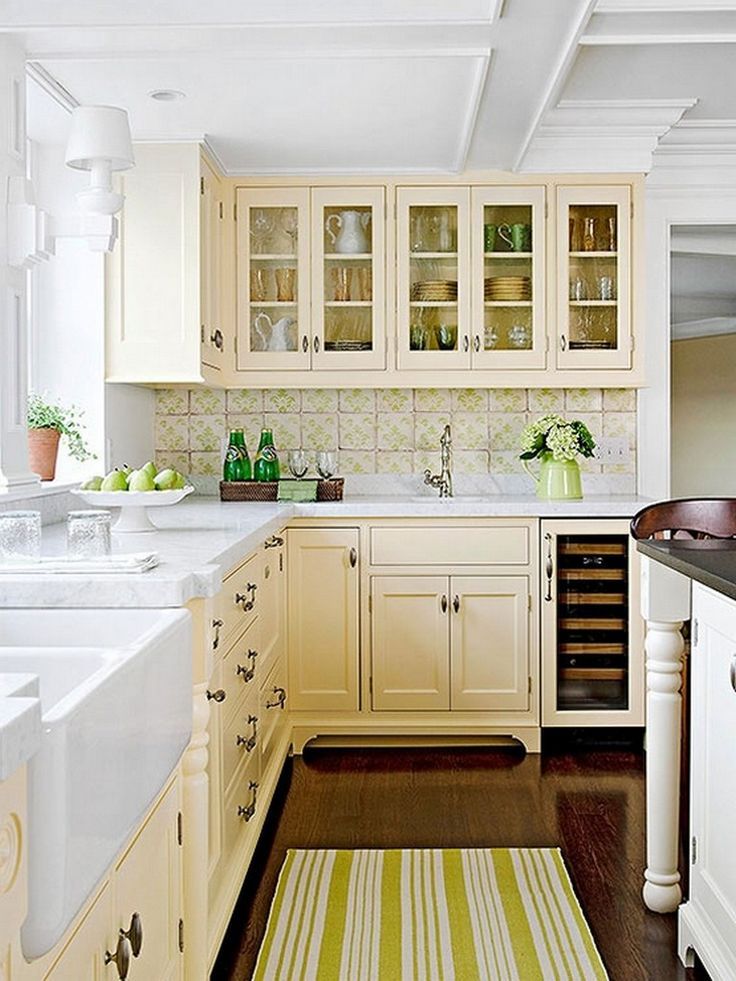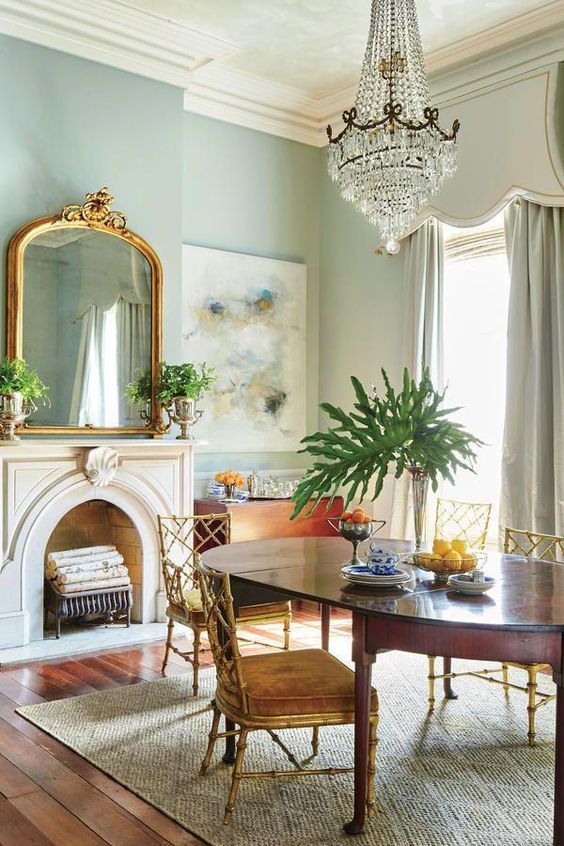Designing a kitchen extension
36 Kitchen extension ideas – to maximise the potential of your space
If you've been dreaming about kitchen extension ideas for a while now, you may be feeling just a little overwhelmed. Learning how to extend a kitchen in the first instance is a lot to get your head round, and that's before you even get started on planning the end result of what your new kitchen ideas will look like.
But that's really where the fun begins because kitchen extension ideas offer a wealth of opportunities. You can plan, design, and bring to fruition your dream kitchen. It might be a spacious kitchen-diner that flows beautifully into the living room or an enlarged kitchen that offers full views of your back garden - or, it might be both!
'The question is how can you extend the kitchen to make the new space work with the existing space,' says George Omalianakis, Expert Residential Architect ARB / RIBA, GOAStudio . 'You want the extension to create an enlarged kitchen, dining, living, and even kid's play area that opens up to the rear garden and that links to the rest of the house in an effortless way. '
So to help you get the kitchen you've been longing for, we've come up with all the best kitchen extension ideas that will bring your dream into reality. Whatever your budget, there will be some ideas in our guide that you can implement into your home. It's time to start planning!
(Image credit: Future PLC)
Kitchen extension ideas
Aside from transforming your kitchen to the space that you need it to be, a kitchen extension will add value to your home, so it's a wise investment. Transform your current cooking space into a socialising and living space too with our pick of the best kitchen extension ideas.
1. Incorporate various roof profiles
(Image credit: Future PLC)
A multifunctional kitchen extension - i.e. one that will house cooking, dining, socialising, and living spaces - will benefit from a varied roofing structure over one bland, flat ceiling. Different ceiling levels will help define and separate the different functions of the new kitchen area, so it's worth thinking about this in the early planning stages.
'Once you have come up with a clear layout of where the kitchen is, where the living area is, and what you would like to connect to the garden, try to then play with various roof profiles to define the various functions of your new kitchen area,' says architect George. 'High ceilings create an uplifting, “cathedral”, effect, whereas lower ceiling areas are more cosy and intimate. Pitched roof profiles will draw your eyesight upwards or downwards leading your brain to read the space you are in differently.'
2. Define areas with different floor levels
(Image credit: Future PLC)
If your extending to create an open-plan kitchen, you want to define separate living, cooking, and dining areas. A helpful way to do this is to have different levels of flooring; you could raise the level of the cooking space above that of the diner, or vice versa, then gradually transition down towards the garden level.
'This is a reflection of how you use this space and how it fits with everything else around it,' says George. 'By lowering the floor level you put a boundary around a dining area for example. By raising the kitchen area you make it the centre of activity, the raised deck where you can also monitor all family and social life from while cooking.'
'By lowering the floor level you put a boundary around a dining area for example. By raising the kitchen area you make it the centre of activity, the raised deck where you can also monitor all family and social life from while cooking.'
3. Consider a conservatory or orangery
(Image credit: Future PLC)
'A conservatory or orangery extension is a really popular choice for kitchens as the abundance of glass allows the room to be filled with vast amounts of natural light,' says Mervyn Montgomery, Joint Director, Hampton Conservatories . 'However, when the majority of the external walls are glazed, the layout and zoning of the kitchen need some additional thinking through.'
You could opt for a kitchen that is heavy on base units to counteract the fact that the glazing extension does not allow for many wall units. The extension can then focus on being a seating and living area, or even a playroom or office space.
If you are building a conservatory or orangery extension, the key is to plan ahead to make sure you still have space for all your kitchen storage.
4. Embrace asymmetry
(Image credit: Future PLC)
Uniquely shaped kitchen extension ideas can create wonderful living spaces that suit their individual household perfectly. Think outside the box during the initial planning stage; you can go for a popular L-shaped kitchen layout or bring something to life that is beautifully asymmetrical, that performs in the way you need it to.
'Often a bit of asymmetry, an organised and considered chaos approach in terms of design, results in spaces that are surprising while they still feel just right,' says architect George. 'Keep an eye on proportions and scale and composition; there is a lot you can achieve with pretty standard construction methods as long as you plan everything in advance and explore a few options during the design development stage.'
5. Plan in the finer details at the start
(Image credit: Future PLC)
Before your extension project gets fully underway, it's important to think about the kitchen layout and design too.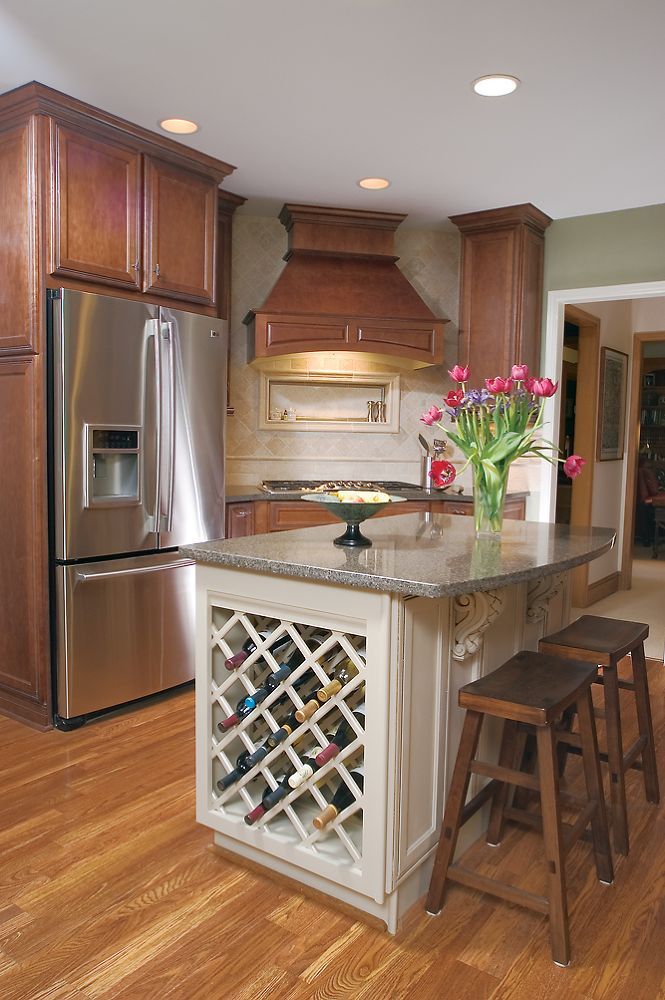 'If possible have some ideas before you decide on the build, so that they can be incorporated at the outset, e.g., drainage points, electric sockets, extractors, windows, etc.', says Mark Mills, MD, Mereway Kitchens . 'This way you save time and money and can even turn a necessary utility into a feature – e.g. support structure.'
'If possible have some ideas before you decide on the build, so that they can be incorporated at the outset, e.g., drainage points, electric sockets, extractors, windows, etc.', says Mark Mills, MD, Mereway Kitchens . 'This way you save time and money and can even turn a necessary utility into a feature – e.g. support structure.'
Remembering to incorporate these nitty gritty details in the early planning stages is something you'll thank yourself for later.
6. Match your extension plans to the foundations
(Image credit: Future PLC)
It's important to understand the footings and foundations you'll be building on, as this will affect the type of kitchen extension ideas you can implement, as well as the project's price tag.
'In terms of the footings - if you have clay, overtime this would depress when you put concrete footings on top so you need to go below clay level, which can be very expensive per square metre', says Ian McConville, Group Procurement Director, MKM . 'This only matters if you are extending upwards. If you are undertaking a side extension you would install new footings anyway.'
'This only matters if you are extending upwards. If you are undertaking a side extension you would install new footings anyway.'
Your architect will be able to go through these details with you, but it's helpful to do a bit of research first so you're prepared for how much work your extension will involve.
7. Turn an awkward space into a utility area
(Image credit: Future PLC)
There will inevitably be one or two areas of your new kitchen that you're not sure what to do with. One wall will stay in the darker part of the room, so you might want to use this space for utility units and chores rather than as a dining or socialising space.
'Utility areas tend to declutter the rest of your kitchen or dining space and you can always find awkward and previously unused parts of the floor plans to turn into utility, storage or to a pantry space,' suggests George, GOAStudio.
8. Add a skylight
(Image credit: Future PLC)
If you're looking to maximise light and make your new kitchen as bright and open as possible, a new skylight the best way to do this.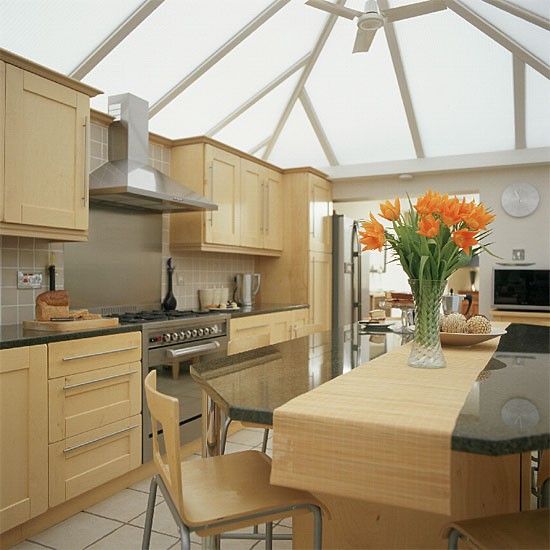 'A skylight allows you to achieve a bespoke look which really opens up the space and allows the light to pour right into the room,' says Thomas Goodman, Property Expert, MyJobQuote . 'Add some glossy features such as cabinet doors or countertops and this will allow even more light to flood the room.'
'A skylight allows you to achieve a bespoke look which really opens up the space and allows the light to pour right into the room,' says Thomas Goodman, Property Expert, MyJobQuote . 'Add some glossy features such as cabinet doors or countertops and this will allow even more light to flood the room.'
9. Consider keeping your extension small
(Image credit: Future PLC)
The size of your kitchen extension will likely be at the forefront of your mind, so it's important to get clear on how much square footage you want to add exactly. Think in terms of floor space; how much more do you actually need for your new kitchen to do exactly what you want it to? Try to stick to this and not go over unnecessarily.
'Kitchen extensions don’t need to be huge to bring in the benefits. Most kitchen extensions are no more than 3 metres in depth, and side return extensions especially are usually quite small', says Thomas. 'Even just a 1.5 metre wide side return extension can dramatically change the room.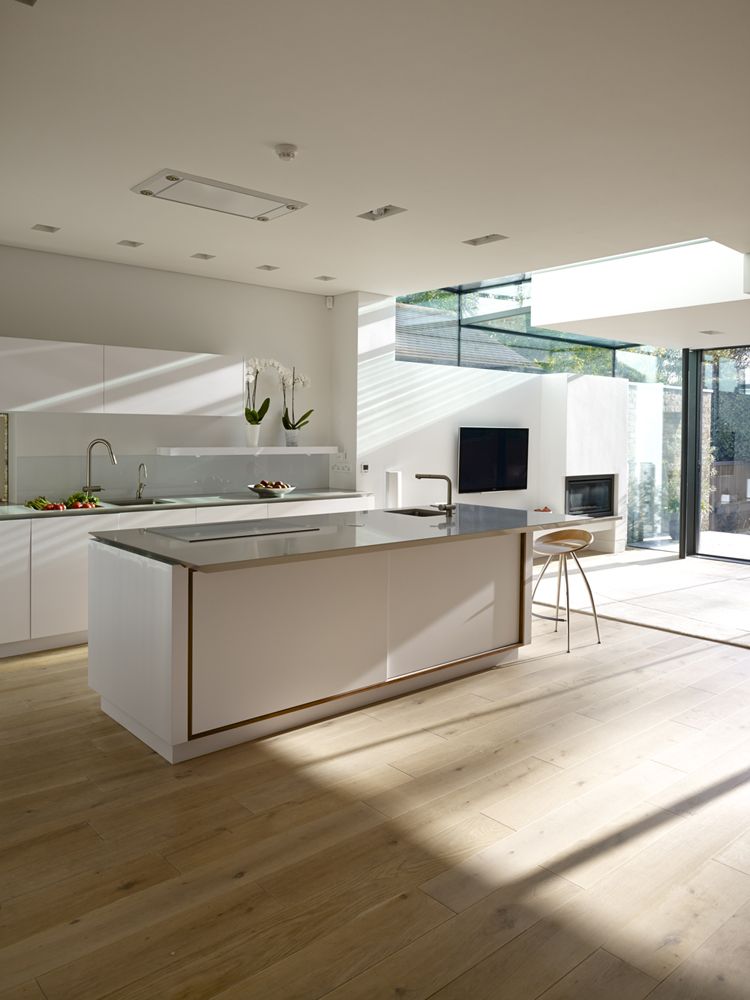 '
'
A small kitchen is usually around 15m2 and a large kitchen is usually up to around 50m2. Keep these numbers in mind as a rough guide when planning your kitchen extension.
10. Make an island the focal point
(Image credit: Future PLC)
Always dreamt of having a beautiful kitchen island as the stand-out feature in your kitchen? An extension will give you the space to do just that. Kitchen island seating ideas are great socialising spaces; they create a place for people to gather round with a glass of wine while the cook sees to meal prep, and they're a great breakfast and lunch spot for everyday.
Plus, you can use your island as extra storage too. Keep your countertops clutter-free and put larger utensils and appliances you don't use everyday away in the confines of your island unit.
11. Create a thoughtful layout
(Image credit: Studio Varey/Alexandria Hall)
Architects Studio Varey transformed this charming semi-detached North London home with a sleek new kitchen extension.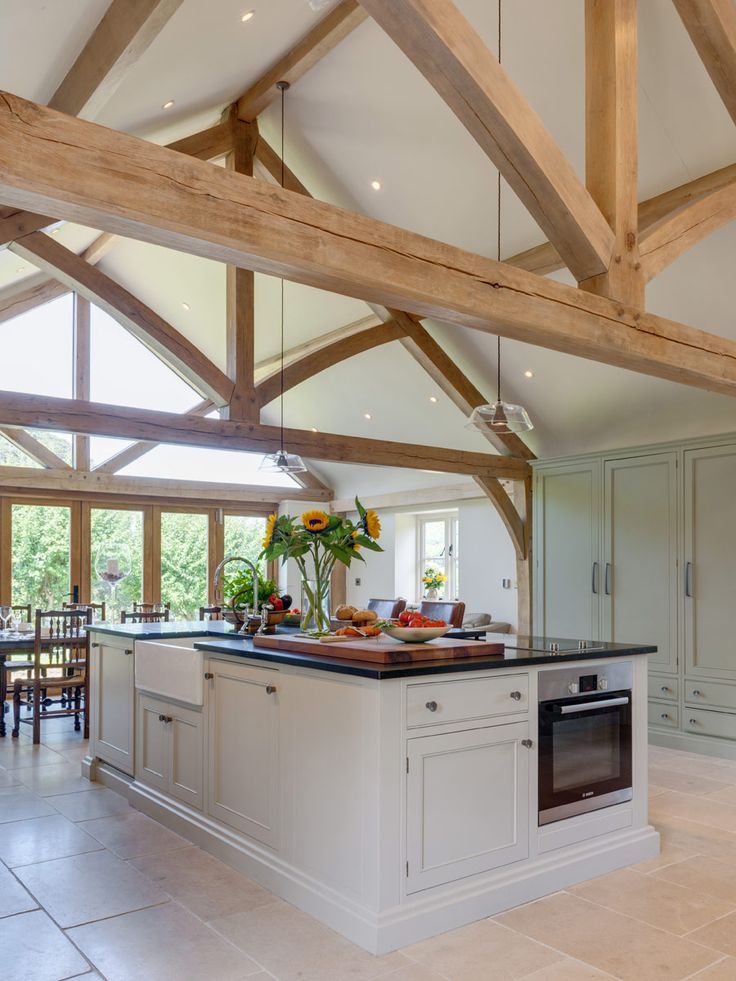 A newly open-plan ground floor houses a modern kitchen /dining space, extending out into the back garden, that takes inspiration from orangery ideas with its large skylight.
A newly open-plan ground floor houses a modern kitchen /dining space, extending out into the back garden, that takes inspiration from orangery ideas with its large skylight.
'The new space is filled with natural light from both the large skylight positioned over the dining table, as well as the expansive glass doors that allow this family to bring the outside in and maximise the home’s connection to the garden' say the design experts. The kitchen design features composite countertops and a large run of tall cupboards, which have created over 50 per cent more usable storage, a key request for this family home.
12. Form a relationship with the outside
(Image credit: Future PLC/Chris Snook)
'One thing to consider when extending outwards to create a bigger kitchen is how natural light will be affected,' says Victoria Brocklesby, COO, Origin . 'In instances where the square footage of a room increases but the number of windows or glazing doesn’t, the space can become dark and uninviting.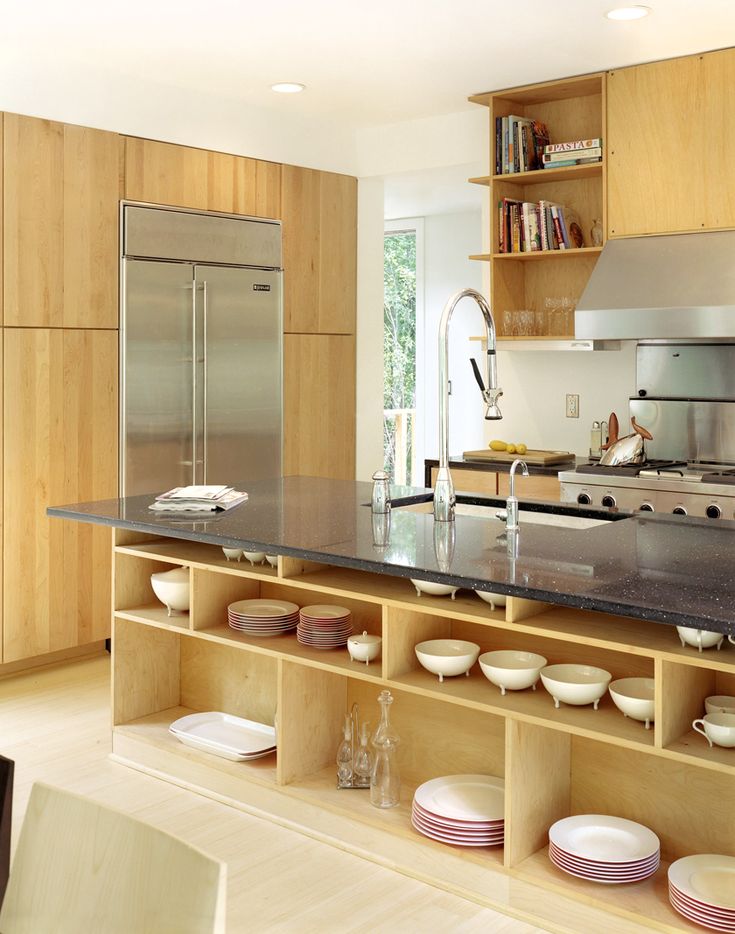 ' Glass sliding doors are ideal for maximising light in the new kitchen space, and opening up the area to the outdoors.
' Glass sliding doors are ideal for maximising light in the new kitchen space, and opening up the area to the outdoors.
This Edwardian house features a modern rear extension which allows the kitchen-dining area to seamlessly flow into the beautiful garden beyond.
13. Envision how the space is best used
(Image credit: Future PLC/Colin Poole)
The main objective with this kitchen extension was to create a spacious kitchen with the island and dining table taking centre stage. 'We used Resi , an architecture practice, to secure planning permission,' explains this homeowner. 'We produced several different layouts on graph paper, detailing the dimensions for the space needed – for things like walking between the island and kitchen units. And what might be required for the seating area.'
‘It was a fairly straightforward design using planed structural timber, double-glazed panels and power-coated aluminium capping. In fact, it was probably cheaper than a slate and Velux alternative and allows plenty of light to flood in.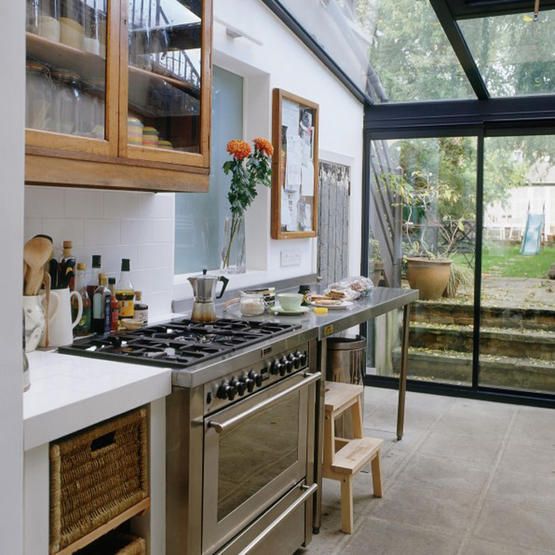 ’ The combination of a glazed pitch roof and large steel-style windows and doors provide a bright, airy feel to the kitchen.
’ The combination of a glazed pitch roof and large steel-style windows and doors provide a bright, airy feel to the kitchen.
14. Mix materials
(Image credit: Future PLC/Colin Poole)
Use a mix of materials to get the best from your kitchen extension. Allow a brick extension to extend the space, retaining structure and warmth within the framework. But pair the brick with steel framed doors that offer an airy feel, allowing the outside to integrate with the indoor space. Further use of glass with a roof lantern adds a contemporary edge to the design, that floods the main kitchen area with natural light.
15. Create a multi-purpose space
(Image credit: Future PLC/David Giles)
At the planning stages work with your architect to create a space that can provide the perfect balance for your lifestyle. A smart kitchen extension that can seamlessly integrate cooking, dining and socialising is a great way to use the space – especially when working from a small floor plan.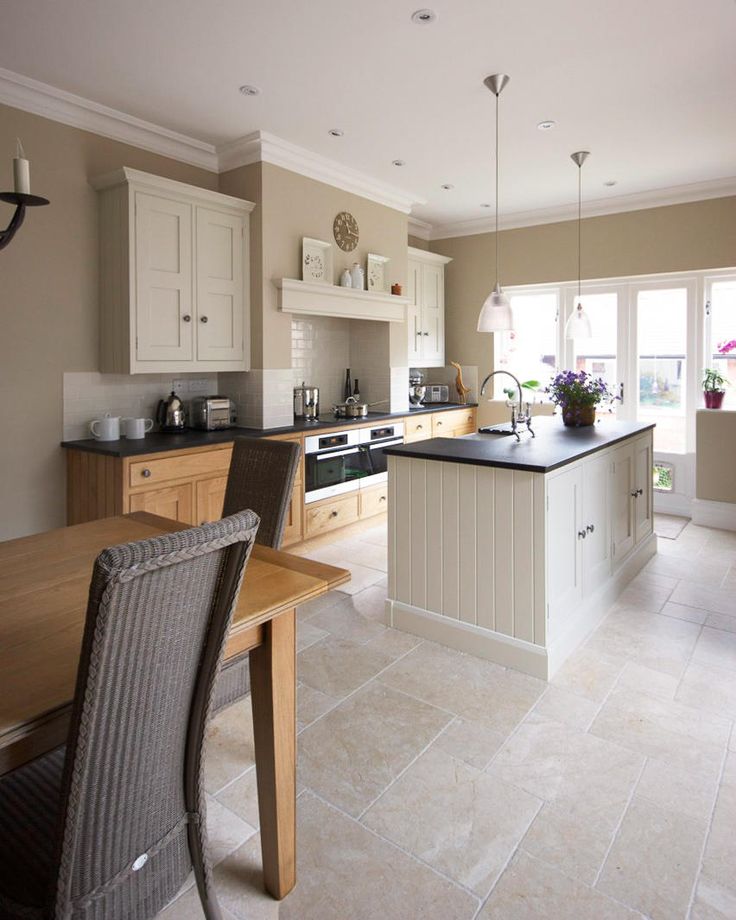
Using larger furniture pieces to help create the different zones is an ideal solution, to save on structural divisions. You can also use colour blocking to define the different zones. Two-tone kitchen colour schemes are hugely popular with larger kitchens, as they help to create visual variety and prevent the space from feeling too big and empty.
16. Make the walls retract
(Image credit: Future PLC)
'Remember: the garden is the “stage” for pretty much all kitchen extension projects,' says architect George. 'You will experience your new space from the inside out.'
Extensions that allows a seamless fusion of outside and inside dwellings are the most popular for a reason. And sliding doors, which all but disappear, are the best way to completely open the space up. Aside from having the freedom to unit the spaces in summer, in winter the glass structure allows maximum light capacity – to keep the space feeling open and airy, ideal in smaller kitchens.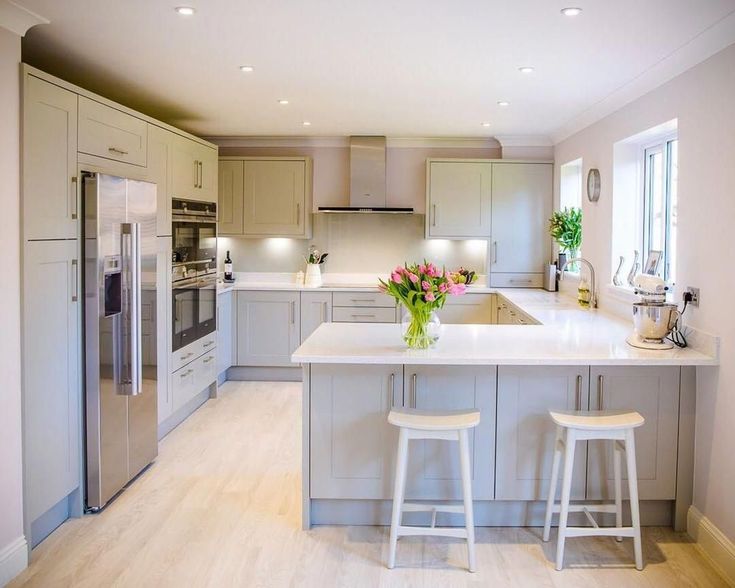
17. Double the size by repurposing a side return
(Image credit: Future PLC/Veronica Rodriguez)
Use redundant space from a side return to create extra space for an open-plan kitchen and dining area. The extra footage will allow adequate room for a more comfortable living arrangement. The extension also opens up the possibility to put in skylights and doors across the back to create a further sense of openness.
18. Use glass to balance the light
(Image credit: Future PLC/Polly Eltes)
This period village house is enhanced by a contemporary glass extension and modern interior. Extending out a few metres beyond the boundary wall is enough to completely open the ground floor space. Where the garden is at a higher level to the ground floor the use of glass across the entire rear extension helps to ensure the sunken space isn't dark and enclosed.
19. Adapt the space to fit the new normal
(Image credit: Future PLC)
Our homes have never had to work harder to incorporate our growing needs.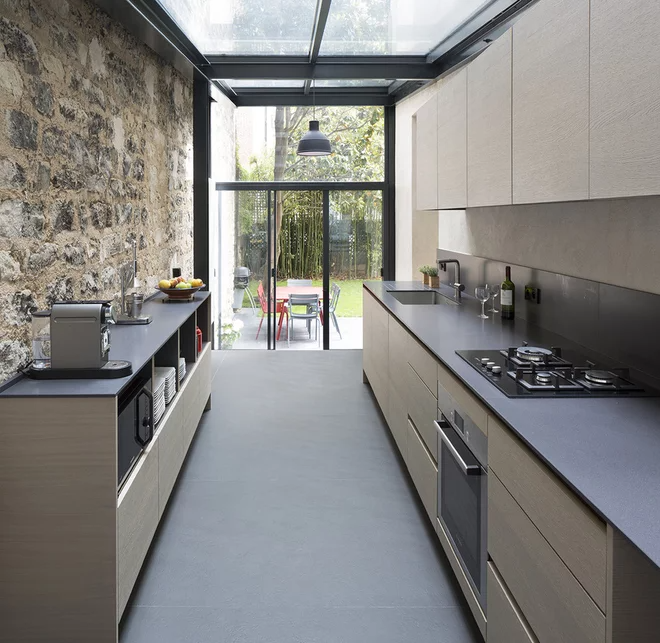 Kitchens have always been considered the heart of the home – and in 2021 they are very much so, as they become home offices, restaurants, classrooms and more. Not to say how we live now will stay, but designers are most definitely sensing this will influence how we use the space in the future. An extension can pave the way for a reconfigured layout that complements your 'new normal' lifestyle.
Kitchens have always been considered the heart of the home – and in 2021 they are very much so, as they become home offices, restaurants, classrooms and more. Not to say how we live now will stay, but designers are most definitely sensing this will influence how we use the space in the future. An extension can pave the way for a reconfigured layout that complements your 'new normal' lifestyle.
20. Use extended glass panels to let the light in
(Image credit: Future PLC/Colin Poole)
Lose a wall by installing glass panels and folding/sliding doors for a space that opens up completely to the garden beyond. This smart extension doesn't go out further, it uses the space vertically to flood the room and incorporate the garden.
Pick and position wall and base units by thinking about the outside space too. Here the honeyed tones cabinetry helps to draw the eye up and out, while the lower cupboards are grounded by a darker hue. All the design aspects work in tandem to open up the space, without having to make a larger footprint for extending. A high traffic throughway will need a hardwearing floor so choose a durable dark-tiled version.
A high traffic throughway will need a hardwearing floor so choose a durable dark-tiled version.
21. Unify the ground floor through thoughtful decor
(Image credit: Future PLC/Polly Eltes)
Extend your kitchen thoughtfully by extending your decor from room to room, so one living space flows seamlessly through to the next. This elegant open-plan kitchen space uses a coordinating colour palette with the sitting room at the front of the house. Along with light fittings and flooring choices that feel at harmony with a living room decor.
22. Put safety first when thinking of the layout
(Image credit: Future PLC/Chris Snook)
Essential if you have small children in the house, the most efficient and safest layout will route traffic away from your oven and hob to ensure kids aren’t likely to get themselves under your feet and into danger when you’re moving hot pans around the room. Make the fridge accessible but don’t put it at the very heart of the room.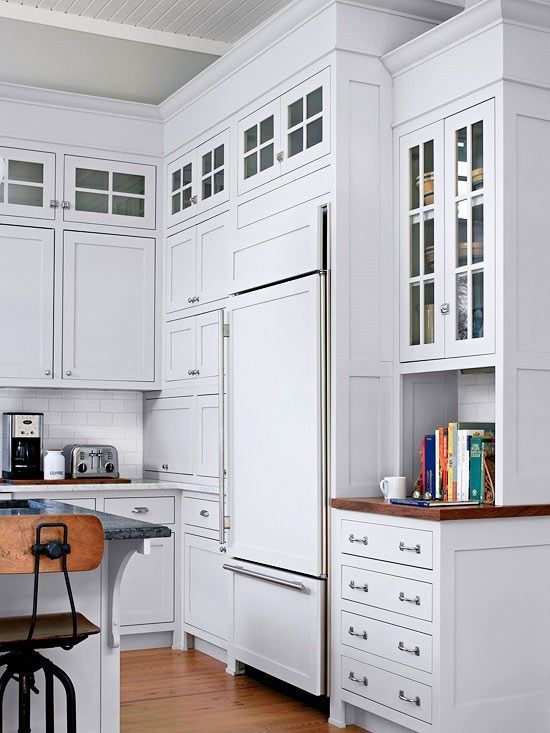 Try placing it to one side, nearest the entrance to the room, so children can help themselves to drinks without venturing into the cooking space.
Try placing it to one side, nearest the entrance to the room, so children can help themselves to drinks without venturing into the cooking space.
23. Incorporate structural elements
(Image credit: Future PLC)
Instead of trying to hide structural steel beams, turn them into part of the design. In this instance the black patio window frames and black steel beam bring balance and interest to this simple white kitchen. Windows in particular should be seen as part of the design rather than a merely functional element, as they have a big effect on the kitchen-garden flow.
'It's good to take some time to consider the glazing and window design options to maximise your visual connection to your garden,' says architect George. 'Dark window frames, minimal framing, and turn-the-corner window arrangements will maximise the effect and bring your kitchen area right into your garden.'
24. Create a viewing room
(Image credit: Future PLC/Brent Darby)
If you have extended into your garden space, make the most of lovely views.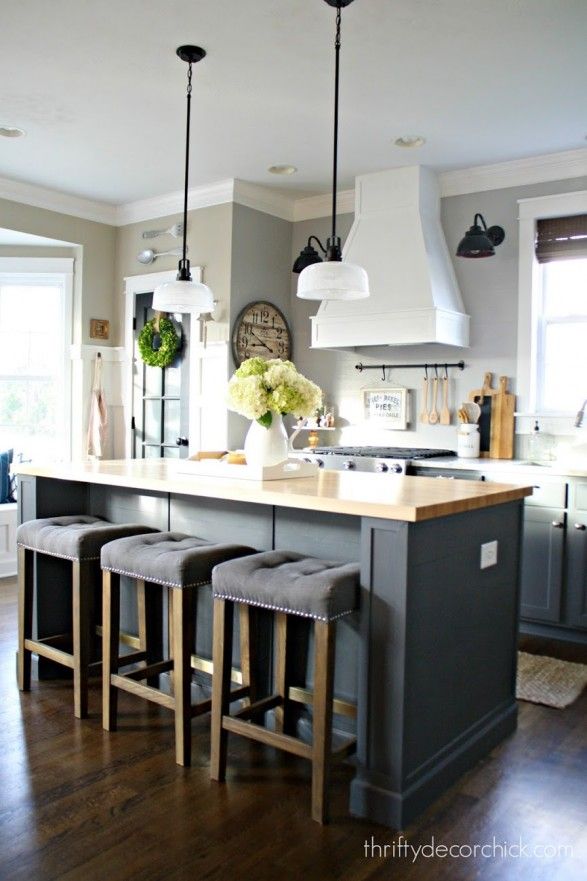 Let the windows be the star of your decorating scheme and wherever possible place furniture where it can oversee your outdoor space.
Let the windows be the star of your decorating scheme and wherever possible place furniture where it can oversee your outdoor space.
'It's not a hard and fast rule, but many homeowners choose to locate their kitchen on the inside wall of the new room, and place their dining area adjacent to the windows and glazing,' says Mervyn, Hampton Conservatories. 'This allows the homeowner to install a long run of cabinetry at the rear of the room with an island in front, looking out into the garden.'
Keep the decorating scheme pared back, and simple so the view is always foremost. Go for matching neutrals across the board with simple decorative touches, a reclaimed table and eclectic chairs. Use glass wall lights for added character at night time.
25. Be brave with clashing colour
(Image credit: Future PLC/Lizzie Orme)
Your newly reconfigured kitchen is the ideal place to use colour. But be sure to thinking about the long-life factor. Love pink, the colour of the moment but scared it will date quickly? Why not experiment with a small section of the wall above the tiles? After all, it's not a huge deal if you decide to change it at a later date.
The key is using a clever combination of materials to create a colour clash. Dilute block colour in a kitchen by separating bold shades with patterned tiles, different shades on cabinets and through accessories.
26. Make storage attractive and accessible
(Image credit: Future PLC/Colin Poole)
Don't want to waste time rummaging for things in the backs of cupboards? Create an open shelving system, like the one in this U-shaped kitchen idea, and you'll have utensils, cookery books and other items that you frequently use to hand when you need them.
Or if open storage isn't your thing, floor to ceiling cabinets will help you make the most of your newfound space. 'Full height, floor to ceiling, cabinet units can provide you with additional storage in an efficient way while retaining clean lines across your kitchen', says architect George.
27. Welcome warmth with brick
(Image credit: Future PLC/David Parmiter)
If you've built a new wall or relocated one as part of your extension leaving the bricks exposed on the inside will give your kitchen character and warmth.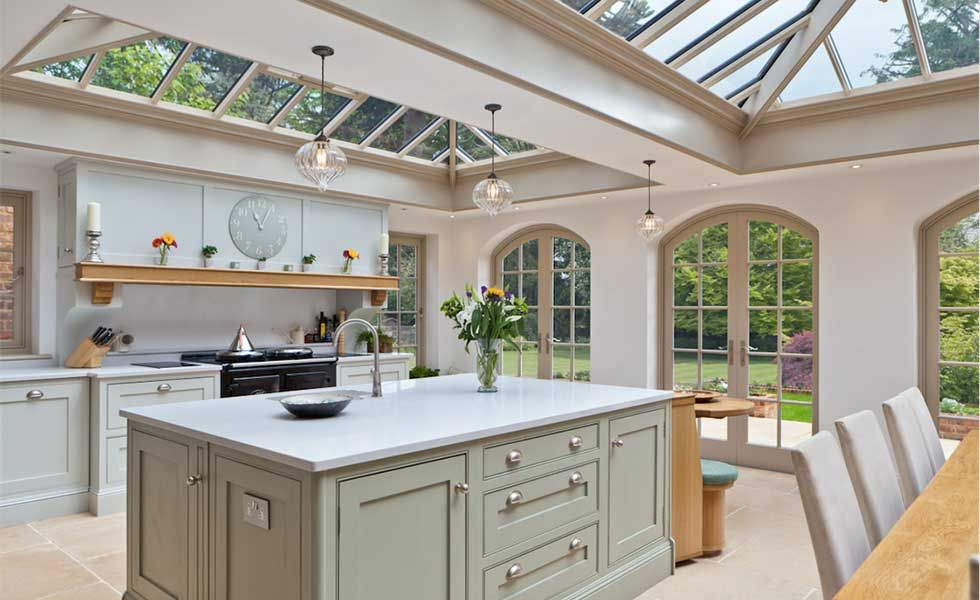 Reclaimed bricks look best as the irregularity of colour and texture will pick up other tones in your cabinetry and flooring.
Reclaimed bricks look best as the irregularity of colour and texture will pick up other tones in your cabinetry and flooring.
28. Extend out with a side return
(Image credit: Future PLC/David Giles)
Extending out to the side is a good option if you live in a semi-detached or detached home, as it doesn’t mean using garden space. You may lose side access to your garden though, and planning permission can be trickier as it will be determined by how close you are to you neighbour’s boundary.
For period terraced homes the path or back garden to the side of a kitchen at the rear, called the side return can be extended into to create a kitchen that runs the full width of the house. Remember, though, to consider how light will then reach the rooms the new space will extend over. You can also combine rear and side extensions for a stunning wrap-around kitchen.
29. Consolidate storage
(Image credit: Future PLC/Richard Gadsby)
Plan your kitchen extension storage with care.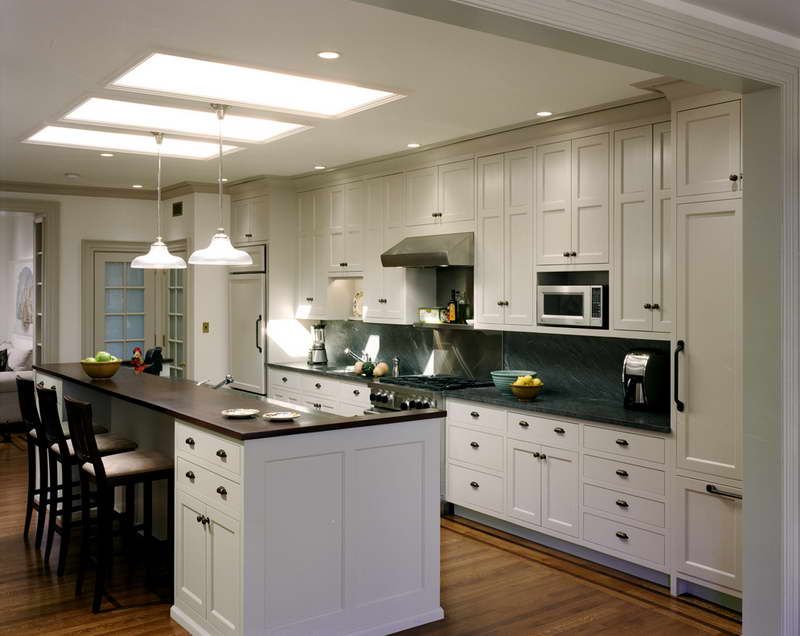 If you have the space, it pays to keep cupboards to a specified area rather than have them dotted all around.
If you have the space, it pays to keep cupboards to a specified area rather than have them dotted all around.
In this impressive extension, base and wall units have been banked together on a single wall and long, full-width island. This not only keeps everything close to hand at the busy, business end of the space, but allows you to co-ordinate your colour scheme - in this case, a dark-grey matt paint finish.
30. Use a peninsula as a divider
(Image credit: Future PLC/James French)
Define the different functions of your extension with well placed units. If you have extended out into your garden from the back wall of your house, the line of the old wall will quite often make a natural dividing point for the new extension.
Here, a rigid steel joist and window mark the spot. The worktop below houses a sink, a couple of cupboards and a mini breakfast bar and divides the working kitchen from the dining and sitting area overlooking the garden.
31.
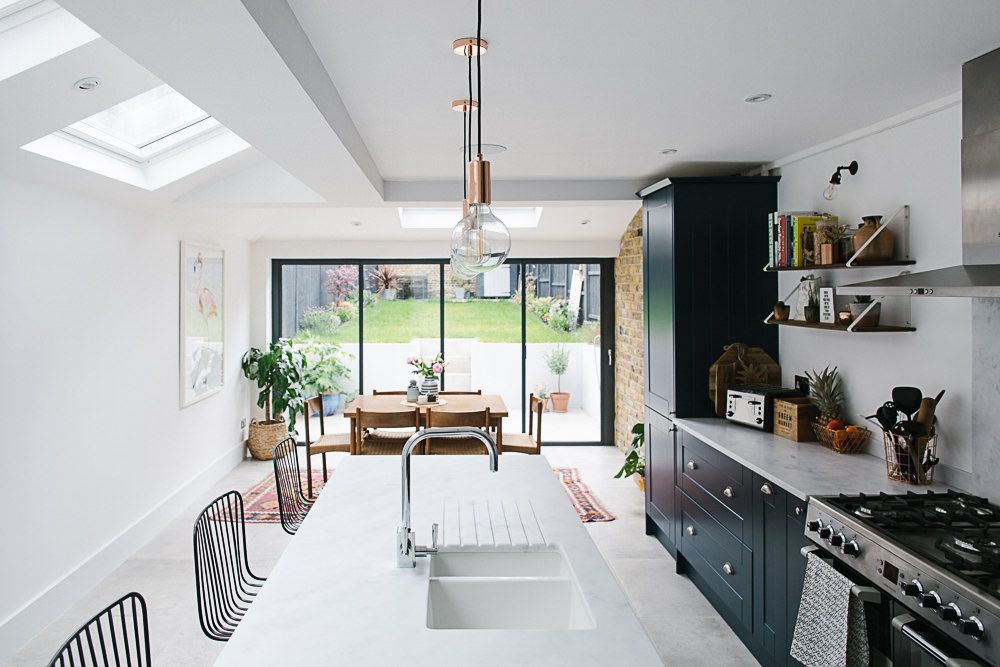 Consider glazed doors
Consider glazed doors(Image credit: Future PLC/James Merrell)
In larger extensions with high ceilings you may feel you need more than furniture to divide up an open-plan space. These full-height sliding glazed doors are a revelation, adding smart, defined verticals to the design and marking a change of function between kitchen and living areas without screening anything from view.
'Statement glazing, like a sliding or bi-fold door, will ensure there is enough natural light,' says Victoria, Orgin. 'These have larger panel sizes, so maximise the amount of natural light entering the room.'
Add even more light with low-hanging pendants, and complement fabulously tall storage emphasise the height of this space. Cornflower blue paintwork and slate wall tiles will unite the decorative elements.
32. Unite a multifunctional space with materials
(Image credit: Future PLC/Alistair Nicholls)
Use a single material throughout an extended space to keep the feel orderly, contained and open.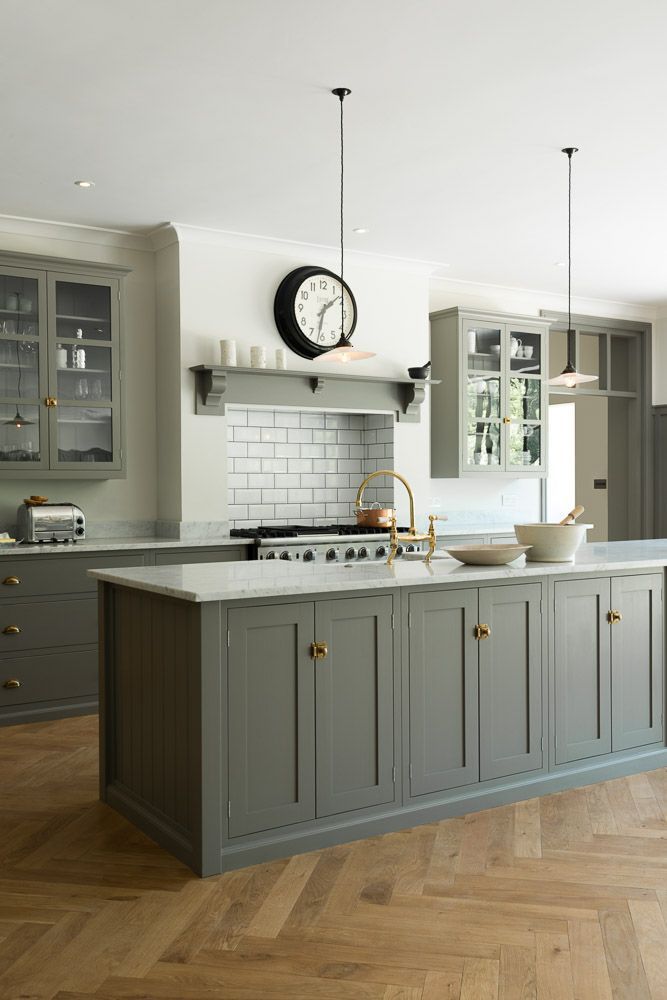 This extension features a country kitchen with breakfast bar, a seating area and separate dining space.
This extension features a country kitchen with breakfast bar, a seating area and separate dining space.
Decoratively, this could be a messy arrangement, but the use of wood throughout brings its own settled order. From the fitted shelves and larder unit at the back of the room, through to the impressive breakfast bar at the centre and out to the low coffee table, farmhouse dining table and mismatched chairs inspired by shabby chic decorating ideas, the warm wood tones unite the scheme. Pops of vibrant colour on soft furnishings and ceramics to add to the fun.
33. Seek out and follow the light
(Image credit: Future PLC/Paul Raeside)
In a kitchen extension, position a dining table where the maximum light falls. In this space, which lacks conventional windows, roof lights bring drama and atmosphere to the table. An adjustable, wall-hung pivot light adds a modern touch.
Look for furniture that fits the space you have as exactly as possible. This table is the width of two place settings and no more, allows room for chairs to move in and out and is the perfect length to make full use of the room's dimensions.
34. Pick simple but strong colour schemes
(Image credit: Future PLC/Fraser Marr)
The modern extension will increase the light levels in a property, so be adventurous with colour in your new kitchen. Working against a white or neutral backdrop, make a strong statement with a black gloss central island and black modern stools that create crisp, clean-lined silhouettes.
Use gunmetal-finish patio door frames to tie in with stainless-steel appliances. Complement and uplift the scheme with a bright yellow splashback and matching pendant lights that draw the eye upward to impressive roof lights. This will simplify and streamline the scheme, particularly in a smaller extension.
35. Blur the boundaries
(Image credit: Future PLC/Richard Gadsby)
Use an extension to continue your kitchen space outside. Choose floor tiles that allow a continuous flow from kitchen to patio, giving the illusion of one large room.
Use the white of your cabinets and kitchen walls on external brickwork, masonry and planters.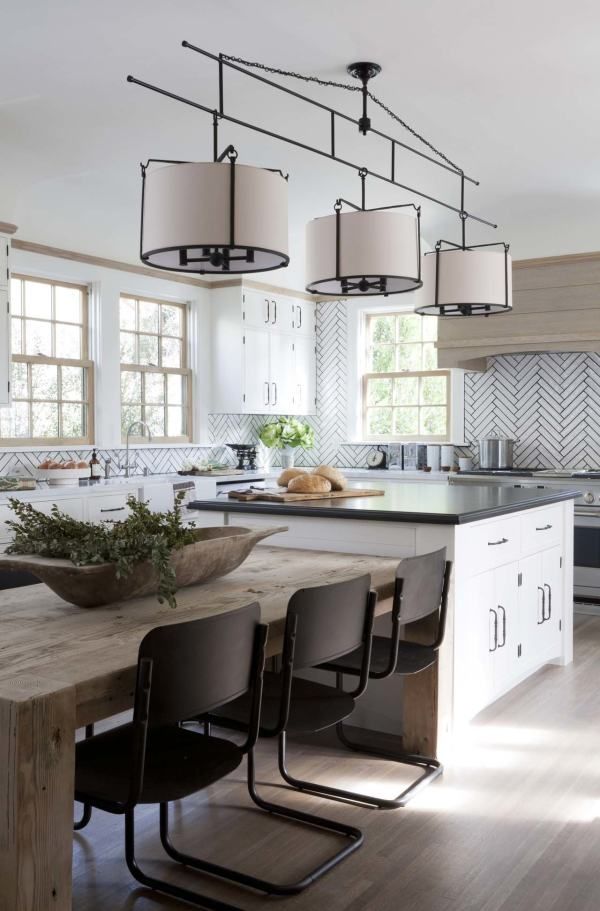 Create an outdoor cooking area that has all the features of a kitchen rather than a barbecue, including a worktop positioned to continue the run of the kitchen version inside.
Create an outdoor cooking area that has all the features of a kitchen rather than a barbecue, including a worktop positioned to continue the run of the kitchen version inside.
36. Colour code kitchen zones
(Image credit: Future PLC/David Giles)
Make large, open-plan spaces work by using colour to define different functions. Try white, handleless cabinetry for a practical, easy-to-maintain cooking and food preparation area.
Introduce a contrast shade on a breakfast bar island to signpost the change of function, but keep the worktop white to indicate that this is a dual-function surface. For dining, go unfinished wood - in keeping with its proximity to the patio, this table and chairs could be mistaken for garden furniture.
Unify the whole with timber flooring, a wooden sideboard and a row of wooden bar stools.
How much is a kitchen extension?
'Realistically, you’re looking at paying an average of £30,000 for a kitchen extension in 2022,' says Thomas Goodman, Property Expert, MyJobQuote .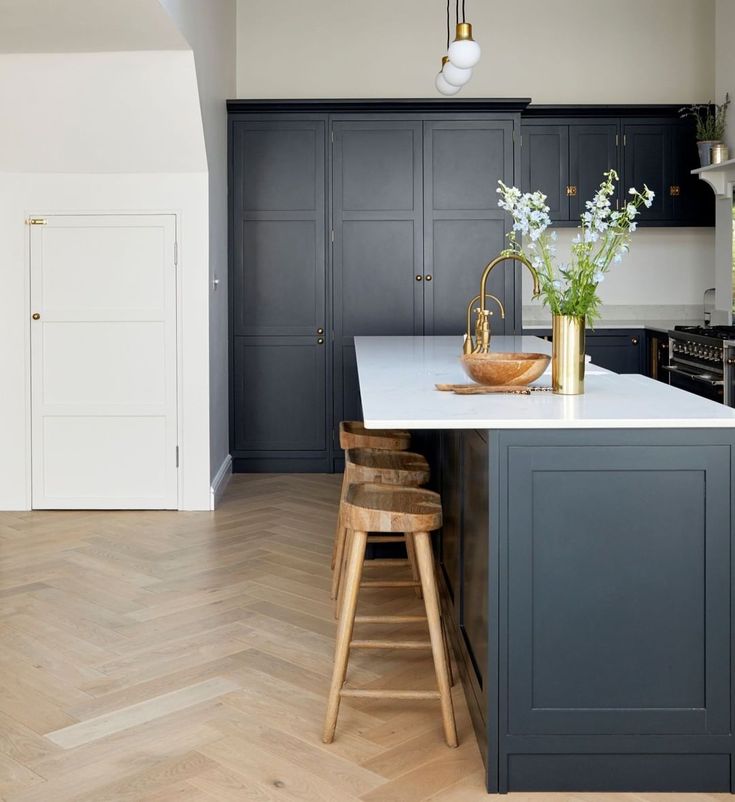 'But costs do vary. A small kitchen extension without any fancy features may only cost £16,000. But if you go for a large extension with a bespoke design and high-end fittings, you’re likely to pay nearer £100,000.'
'But costs do vary. A small kitchen extension without any fancy features may only cost £16,000. But if you go for a large extension with a bespoke design and high-end fittings, you’re likely to pay nearer £100,000.'
The kitchen extension cost will vary dramatically from project to project. Factors like the size of the extension, the location, bespoke features, and planning permissions needed will either plus or minus a few zeros on to the final price.
It's helpful to think of kitchen extension cost in terms of cost per sq m, so you can track the rise in price along with the increase in size. According to Natalie Mitchell, Property Expert, HomeHow.co.uk , current prices per sq m for a kitchen extension are around £1400 - £2000. If you're also installing a new kitchen suite (appliances), you can expect to pay around £200 - £1000 per sq m for the kitchen suite.
It's important to be as detailed as you can during liaisons with your architect, so they can give you as accurate a quote as possible. 'If you are getting a rough build cost calculation from a builder or an architect, this will usually be for the ‘shell’ of the extension,' explains Sky Moore-Clube, Architectural Designer, Urbanist Architecture . 'If the extension will include big-ticketed items such as a kitchen, the type of kitchen you want could dramatically affect the final cost.'
'If you are getting a rough build cost calculation from a builder or an architect, this will usually be for the ‘shell’ of the extension,' explains Sky Moore-Clube, Architectural Designer, Urbanist Architecture . 'If the extension will include big-ticketed items such as a kitchen, the type of kitchen you want could dramatically affect the final cost.'
Do you need permission to extend a kitchen?
(Image credit: Future PLC)
Most kitchen extension ideas will need planning permission, unless they fall under permitted development. The different forms of permission your extension requires will depend on the type of property, the location, and how the new extension relates to the adjacent boundaries with the neighbours.
'If your property has Permitted Development Rights (this often applies to non-Listed houses that are not in Conservation areas, but not to flats) you might be able to add an extension that needs no prior planning approval', says George Omalianakis, Kitchen Extension Expert, GOAStudio .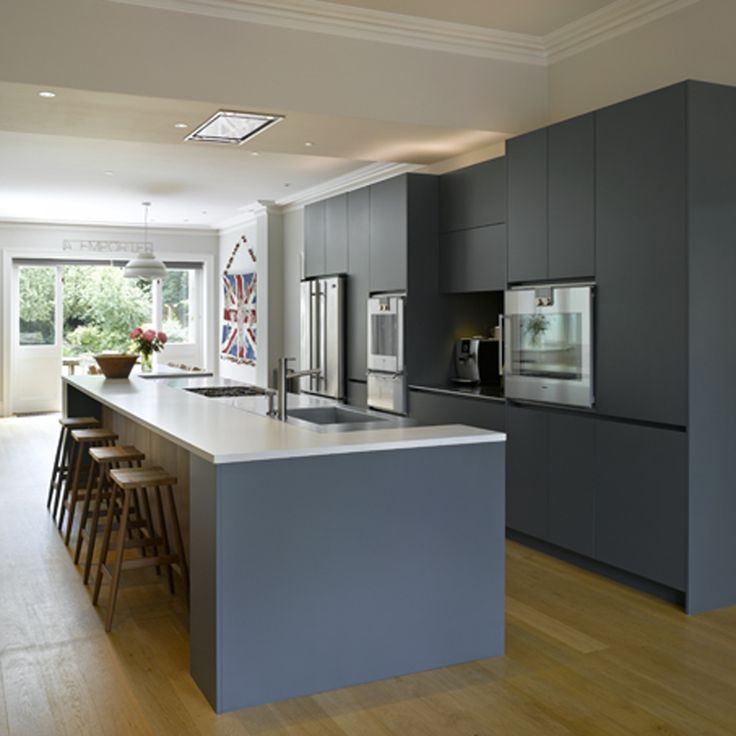 'But you will be limited with what you are able to do in terms of design, as Permitted Development requires that you tick a number of boxes.'
'But you will be limited with what you are able to do in terms of design, as Permitted Development requires that you tick a number of boxes.'
A single-storey rear extension is usually the most planning permission-friendly extension project, and can often be achieved under permitted development. Keep in mind the balance between house and garden, as swallowing up too much garden may be detrimental to the property's value. A simple side extension is also planner-friendly and can widen a narrow kitchen without stealing precious outdoor space. Side-returns are a common choice for terraced properties, which often have a half-width kitchen tacked onto the rear.
You will likely need to seek Building Regulations approval as well, which covers a number of technical and structural matters including the insulation levels, fire regulations, structural safety, weatherproofing details etc.
'You will also need to deal with any relevant Party Wall matters if you build near the boundary with your neighbours', adds George. 'And if your property is leasehold then you will need to obtain approval (often called License to Alter) from your Freeholder. It's best to ask a solicitor to advise on the terms of your lease and how you go about obtaining approval from your Freeholder.'
'And if your property is leasehold then you will need to obtain approval (often called License to Alter) from your Freeholder. It's best to ask a solicitor to advise on the terms of your lease and how you go about obtaining approval from your Freeholder.'
Working with an architect or planning consultant can increase your chances of success at this stage as they will be aware of local planning policy. It can also help to find similar extensions on your street, as these can serve as a precedent for your project. Refer back to GOV.uk throughout the planning stage, as this will keep you informed of all the relevant info.
Will you be using any of these kitchen extension ideas?
Planning a kitchen extension: the ultimate guide
OK, I admit it: planning a kitchen extension is rather a large home improvement. It’s way more than a new lick of paint or new pieces of furniture, so requires precision planning. But as well as finding that we’re spending double the time thinking about improving our homes, a study of 2,000 Brits by Independent Network powered by VEKA, found that we’re spending an average of eight hours and 21 minutes a month making their residences perfect – that’s up from four hours and 44 minutes pre-lockdown.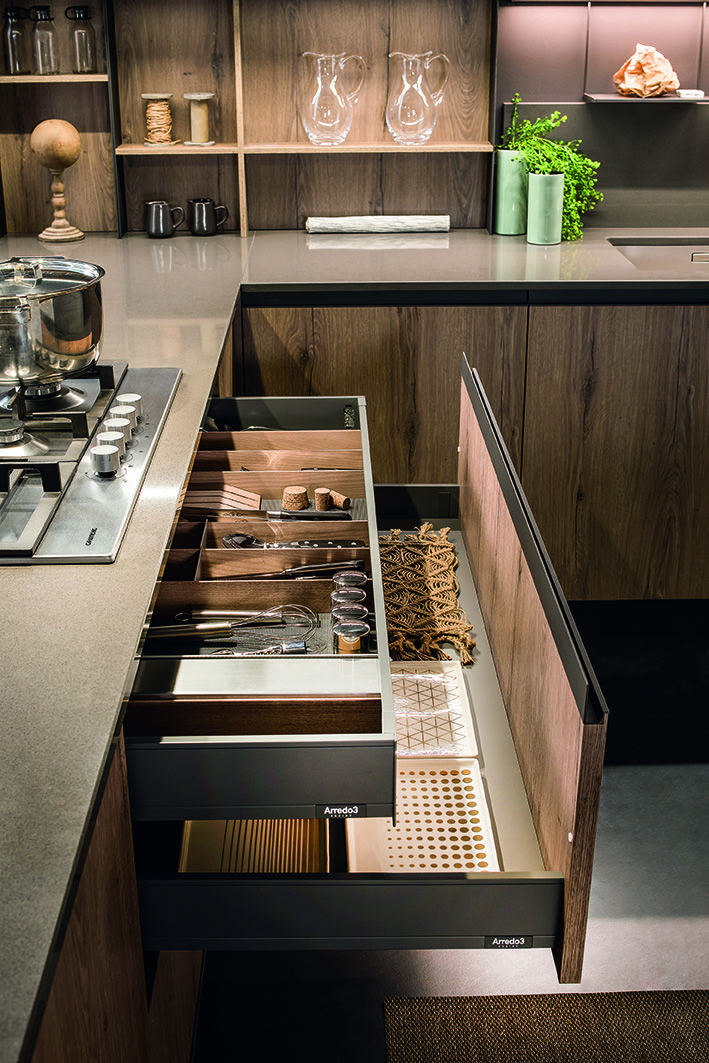 Woah.
Woah.
To be honest, this is music to my ears as I firmly believe that the best home renovations come from hours/days spent planning and scrutinising what you want to achieve and why, plus what you’d like it to look like by the end. Plan, plan, plan I say (I’m a fan of a spreadsheet, which I’m sure the rest of Team These Three Rooms would happily attest to).
To help you along with your kitchen extension planning, I worked with Jill Morgan and Charlotte Luxford, who both write for Kitchens Bedrooms & Bathrooms magazine (the print side of These Three Rooms) to come up with some tips. Here goes…
1. Create a wishlist
The first thing to consider when planning a kitchen extension is how you’ll spend your time in it, what’s possible for the space and how you can use it most efficiently.
Assess your existing room, noting the elements you want to keep as well as any bugbears. Then write a wishlist, prioritising your key items. This may be things such as an island, large patio doors and lots of glazing, a larder or utility room.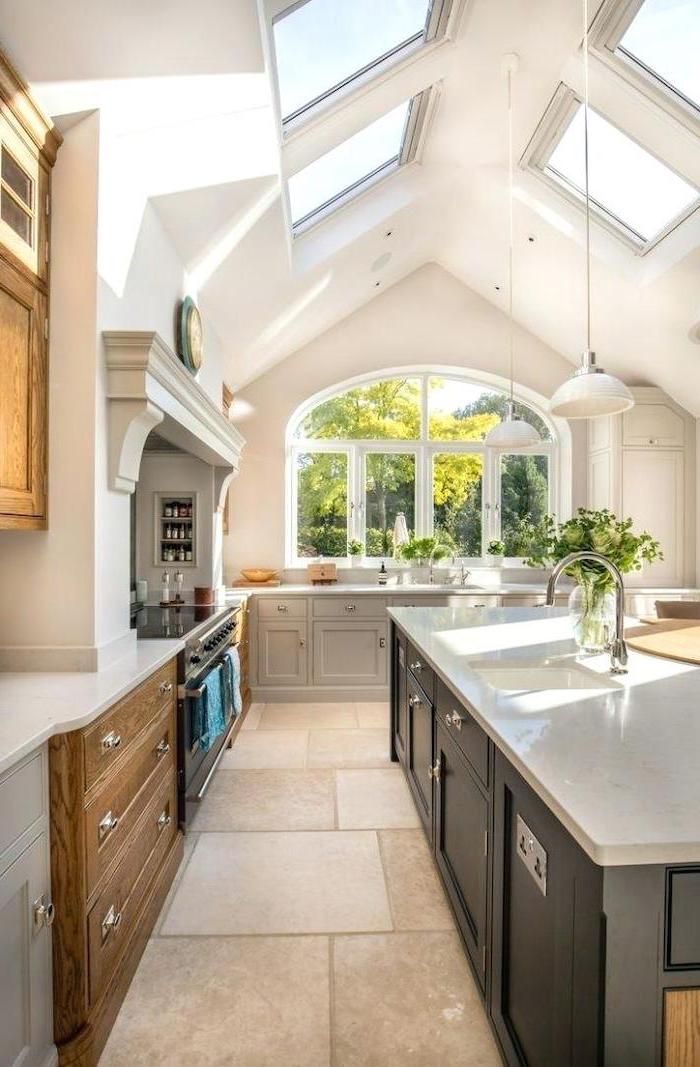 A better link to the garden and more natural light are reasons we hear often, too.
A better link to the garden and more natural light are reasons we hear often, too.
Think about your interiors style, too – do you want a streamlined look? This usually involves integrated appliances and floor-to-ceiling cabinets. Or want more of an eclectic appearance? This usually has a more relaxed feel might mean a large vintage dresser takes centre stage.
You should make a list of the key essentials you want in your kitchen – the ones you cannot live without. Place them in order of preference and give this list to your chosen kitchen designer.
Be realistic and take the opportunity to get rid of any features or products (I’m thinking those gadgets in the back of the cupboard) that you never use, even with the best intentions. Think carefully and deeply and note everything down – likes and dislikes. It’ll be a handy reference throughout the project if you begin to doubt anything, too.
2. Set a budget
Charlotte asked Ben Burbidge of Kitchen Makers By Burbidge for his top budgeting tips when planning a kitchen extension.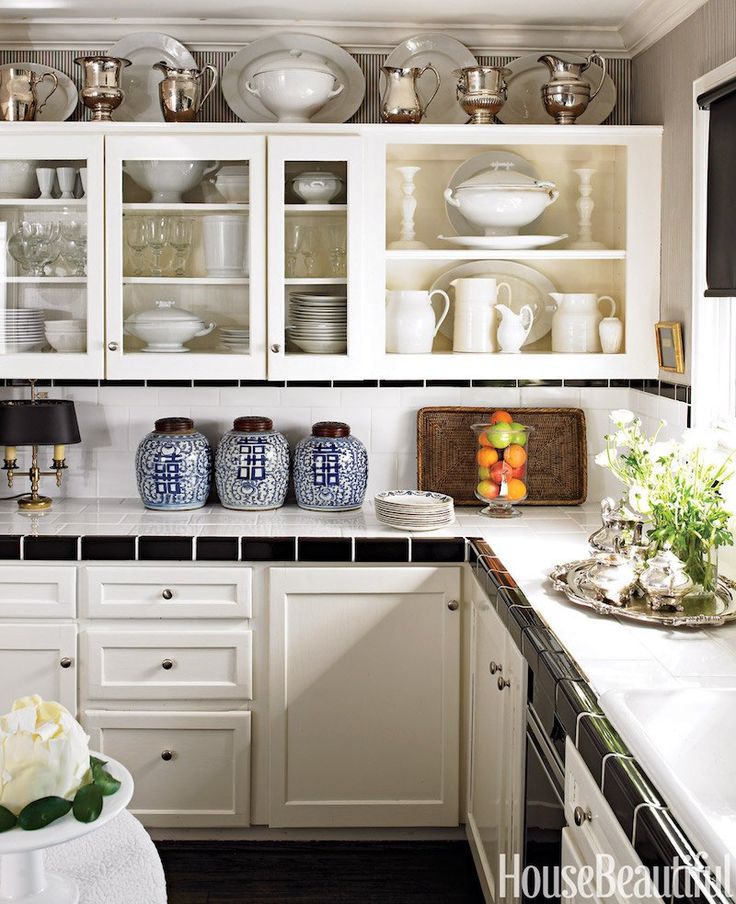 He said: “Be realistic about what you can achieve and the structural work involved, as adding roof lights, changing entrances, moving pipes and rewiring will make it more expensive.” So think about the extent of work you think you’ll need and whether you’re planning to relocate the kitchen and its plumbing or can work with the layout as it is.
He said: “Be realistic about what you can achieve and the structural work involved, as adding roof lights, changing entrances, moving pipes and rewiring will make it more expensive.” So think about the extent of work you think you’ll need and whether you’re planning to relocate the kitchen and its plumbing or can work with the layout as it is.
Don’t forget to budget for planning permission and building regulations approval. A single-storey extension will usually cost between £1200 to £3000 per sq m, depending on the level of finish, plus always set aside a 10% contingency.
Want to keep costs down? Choosing standard building materials and regular fittings for key items such as glazing can help save money.
Of course, you’ll need to budget for the kitchen itself, too. If your dream design is out of reach, consider
buying a used or ex-display kitchen from suppliers including The Used Kitchen Company or Used Kitchen Exchange. Do remember that finishes including marble worktops or parquet flooring will mean a large investment, so best to factor these in from the start of your planning.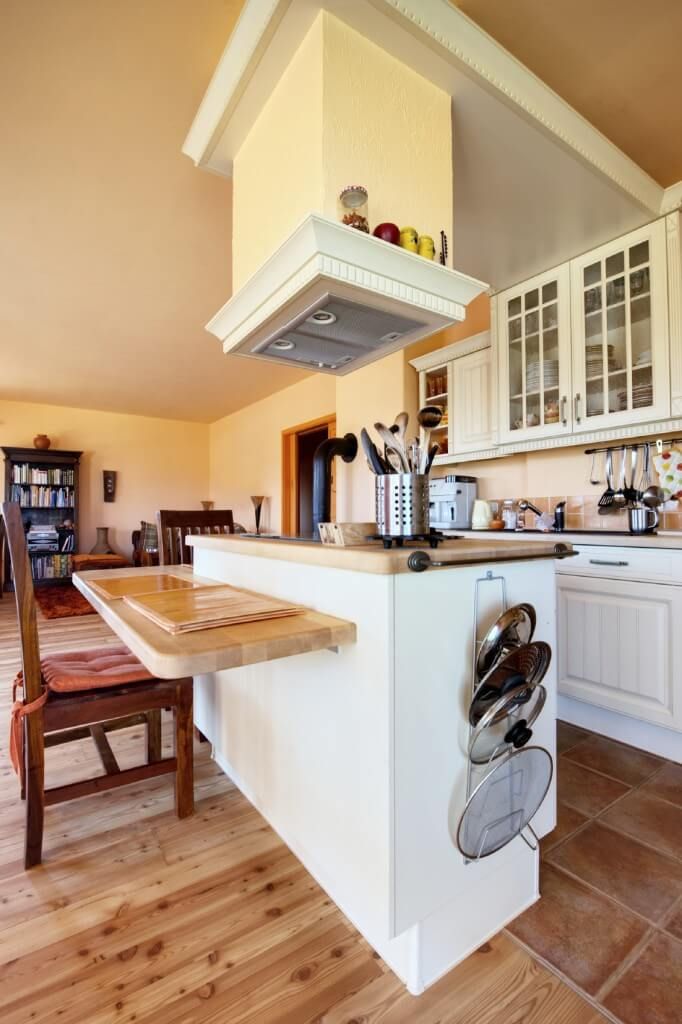
Bespoke isn’t always the most expensive either – sometimes local cabinet makers can create your desired look for less and take in your exact needs and work to the money available. See our Close to Home initiative to find your local, independent design specialists.
3. Find out if you need planning permission
Sounds boring, yes. But crucial, absolutely. With any project that impacts on your home’s outside space, you may require planning permission from your local council. If you do require it, looking to see what work has been done in your street can indicate as to whether your plans will be approved – valid excuse to be a nosy neighbour.
This 3 x 3m rear extension was covered under permitted development rules. The construction was overseen by Plus Rooms and extension designed by architects The Art of Building. Photography: Fine House Photography.If someone down the road has had a kitchen extension, this may signal that you’ll be able to do the same.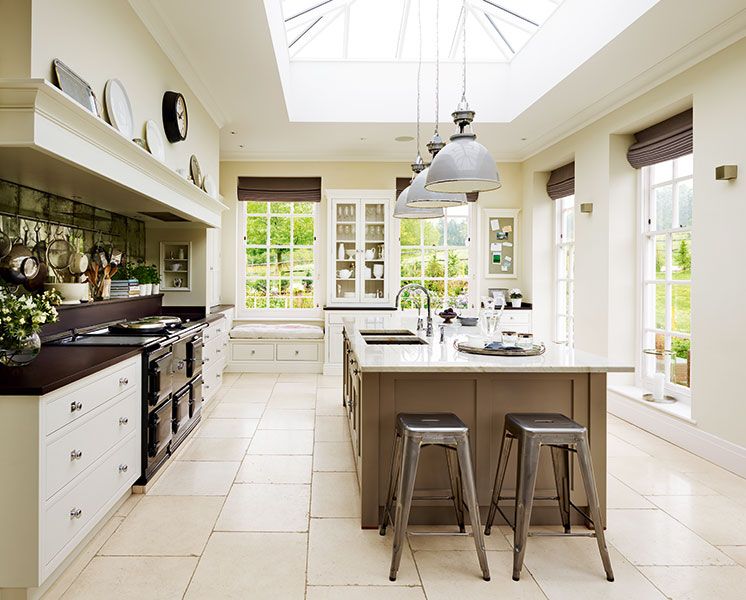 Maybe give them a knock and find out what their project was like and how the planning permission process was for their project. However, even if your street is full of new extensions, best to check in with the council about your home – there may be different rules depending on your home’s location, property type or proximity to next door, for example.
Maybe give them a knock and find out what their project was like and how the planning permission process was for their project. However, even if your street is full of new extensions, best to check in with the council about your home – there may be different rules depending on your home’s location, property type or proximity to next door, for example.
The good news is that many modest kitchen extensions fall within permitted development. This is where you’re able to build without the need for formal planning permission up to a certain size depending on your property type and whether it’s been remodelled before. Although it’s a good idea to seek Prior Approval for peace of mind.
Check out guidelines online: planningportal.co.uk lists all you need to know for England and Wales. For Scotland, head to eplanning.scot.
Remember, your home’s permitted development allowance will depend on where in the UK you are as well as if it has been previously developed. If you live in a conservation area, an Area of Oustanding Natural Beauty, or in a listed building, you’ll likely face stricter terms for planning, too.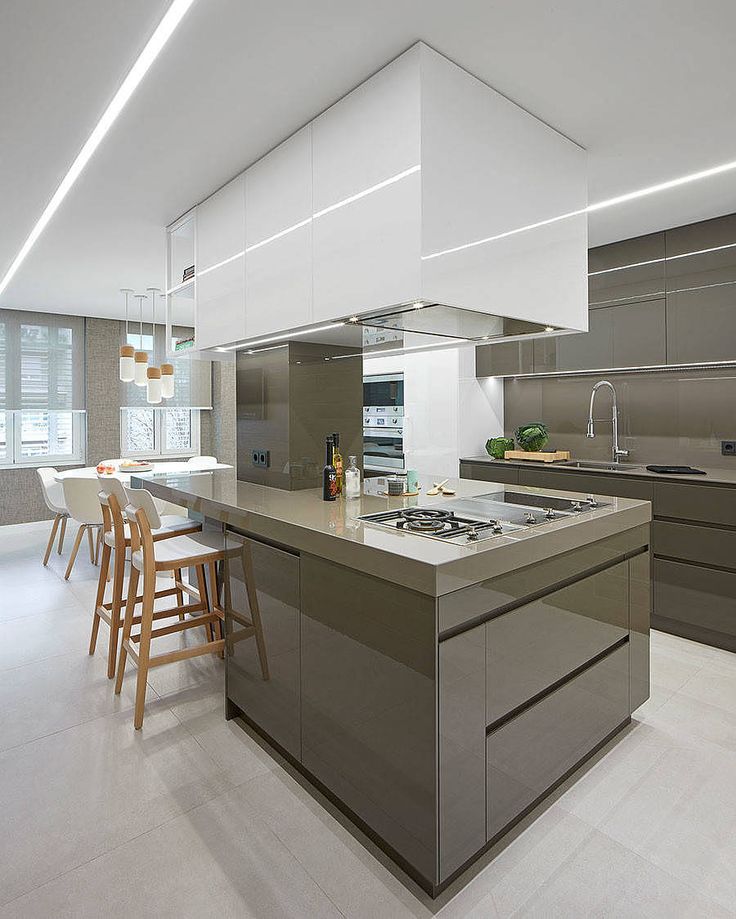
Also check out your local Building Control, as an inspector will be required to ensure your project meets Building Regulations.
Watch The Kitchen Sessions: Plan your perfect kitchen extension
4. Decide on the type of kitchen extension
This is largely dictated by the size and shape of the available outside space and by what’s allowed by the council. The most common type of kitchen extension is a single-storey one to the back of the house, or a side-return extension which is popular on Victorian terraced houses – filling in the narrow space that projects from the back (usually where the bins are kept, right?).
The homeowners had been living in their ground-floor flat within a Victorian villa in Clapton, east London for several years before they decided to renovate it. They replaced a dilapidated glass conservatory with a striking extension designed by Scenario Architecture.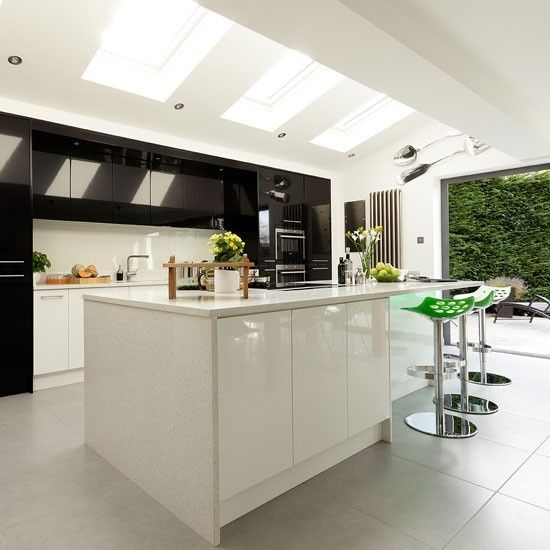 As the property is located within a conservation area, the new addition had to be sensitive to the original layout. This was achieved by keeping the original rear wall of the house intact, using its window and door openings to create internal balconies, and cladding the exterior in sustainably sourced timber. Photography: Matt Clayton.
As the property is located within a conservation area, the new addition had to be sensitive to the original layout. This was achieved by keeping the original rear wall of the house intact, using its window and door openings to create internal balconies, and cladding the exterior in sustainably sourced timber. Photography: Matt Clayton.You can combine the two types to form a wrap-around extension, forming an L-shaped addition, which could help boost space inside and square off a room. The aim of all: create more space, so your perfect kitchen can be sited within it, along with a dining area or living area (or both) should you wish.
When you’re planning a kitchen extension, always keep in mind what sort of kitchen style you’re after, what’s on your wishlist, whether you want an island, etc, as these elements should factor into the extension design as well as the kitchen design. Think in tandem: kitchen and extension together.
This will not only help keep your vision clear, but also help you decide on where to put things such as windows, doors, plug sockets and light switches.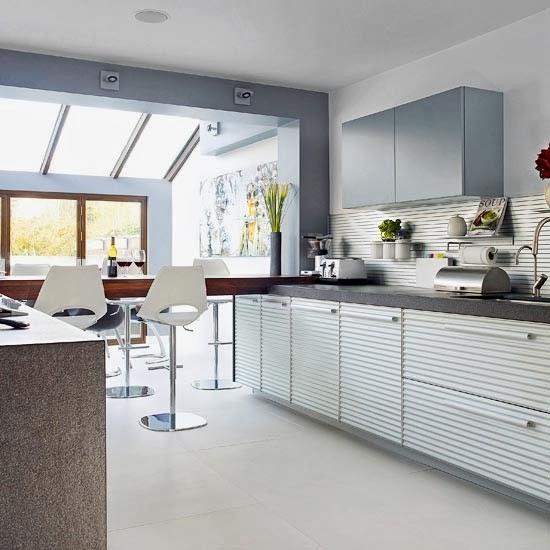
I told you my motto is ‘plan, plan, plan’ and it really is true for a large project like a kitchen extension. The more you can plan before any work begins, the better.
So when you’re planning a kitchen extension and looking around for builders and architects (ask friends and family for recommendations, or seek them out via verified trade bodies), engage with a kitchen designer too, even if only just starting out.
Don’t only rely on your architect’s concepts for the space – now’s the time to start shopping around for a kitchen and use free consultations so you can cherry pick the best ideas.
They will work with your builder or architect to get the most from the plans.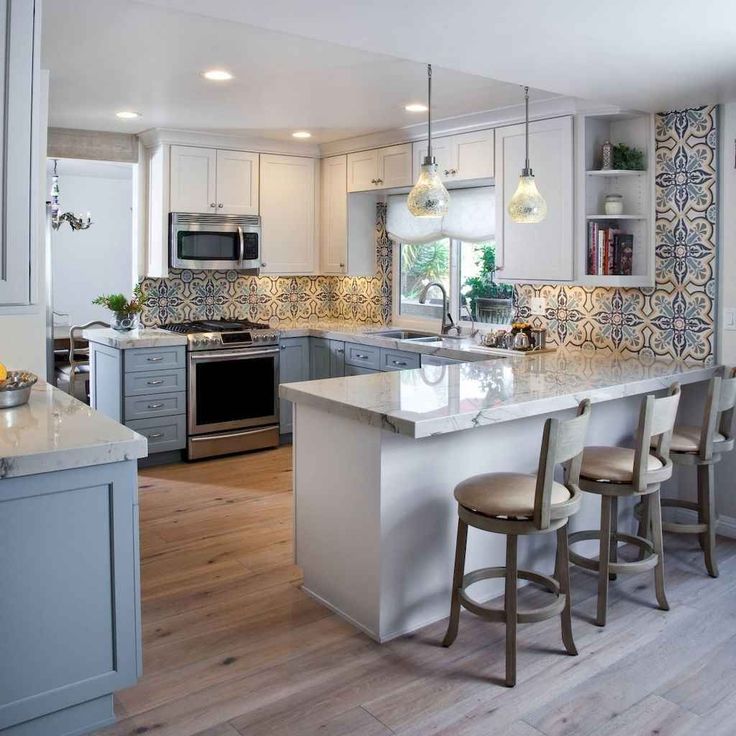 Plus, they’ll help build a picture of how you will use your kitchen and come up with the best, most creative and cost-effective way to make this a reality.
Plus, they’ll help build a picture of how you will use your kitchen and come up with the best, most creative and cost-effective way to make this a reality.
“It’s really important to design your kitchen before or during the planning stages of your extension,” Sophie Randall at John Lewis of Hungerford said. “If you approach a kitchen designer once planning permission has been granted, you risk not having the space for the scheme you really want.”
Make your designer aware if you’ve got a very specific look in mind (cue wishlist) or whether there are any existing elements you’d like to keep and incorporate. Ensure they have a vision for the whole space and ideas for how the kitchen will connect with the other areas, such as dining, living and working zones.
Then establish exactly what services your chosen company offers and whether you want them involved at the design stage only or later in the process. Initial meetings are often free of charge, followed by a fee of a few hundred pounds to take the design further, which is offset against the kitchen. For an all-inclusive service, expect around 10% of the total cost.
For an all-inclusive service, expect around 10% of the total cost.
A kitchen designer will also be able to work with you and your other trades (think of them as your dream team) to suggest best layout, materials and how to create good flow from the kitchen to other areas of the kitchen extension, through to outdoors, too.
Simon Taylor, managing director at Simon Taylor Furniture, made an interesting point: “A glazed wall or bi-folding doors allow plenty of natural light to flow into the space so I wouldn’t recommend having a timber or even hand-painted kitchen in this space, as the light would fade the furniture over time.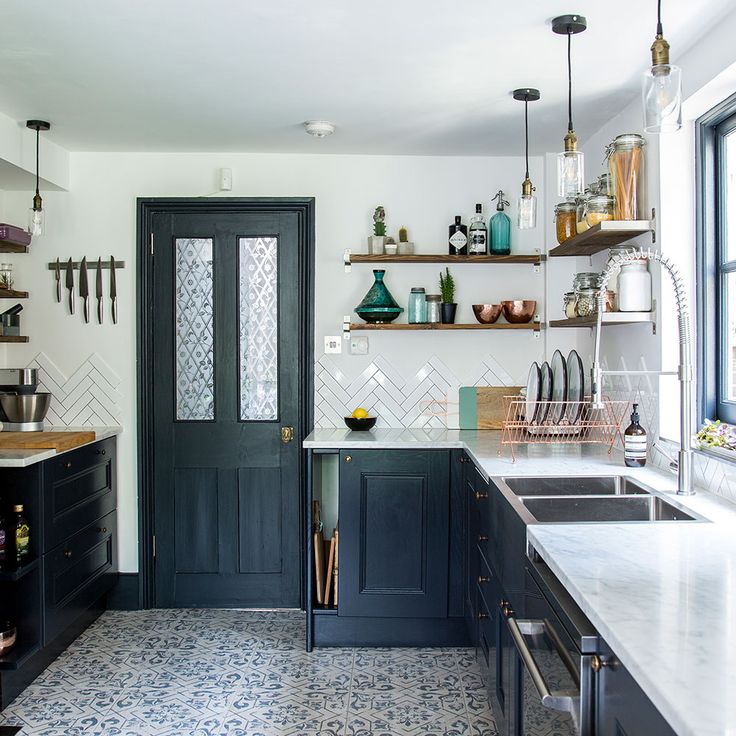 ” Little nuggets of information like this are invaluable to a good kitchen extension project, I reckon.
” Little nuggets of information like this are invaluable to a good kitchen extension project, I reckon.
6. Think about your kitchen layout
When planning a kitchen extension and deciding how much room you need for the actual kitchen, look at your storage needs and assess whether you require the same or more units, and how that translates into floor and wall space, as well as the size and type of cupboards and drawers.
For good flow, it’s leave 1 – 1.2m clearance around and between your units, which can have a big impact on your design, especially if you want an island.
I asked Jayne Everett, design director at Naked Kitchens for her best starting point. “The all-important working triangle,” she said. “Keep the path between your sink, fridge, and hob clear to make cooking much simpler. Don’t try to squeeze in more or larger units if there’s no space, as it will make the room feel small and cramped.” Roger that.
Natural illumination and glazing will also dictate your layout.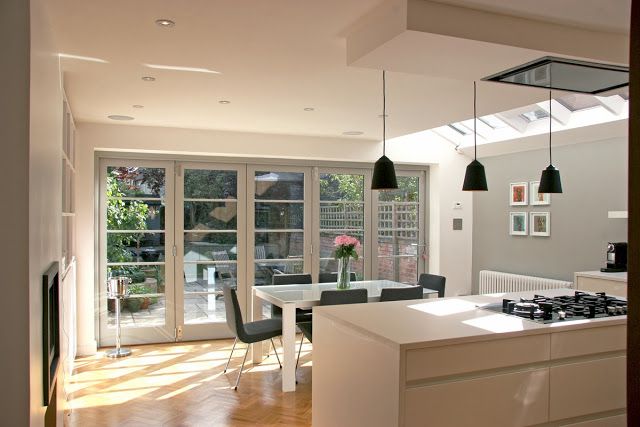 Ideally, you should locate the kitchen in the darkest part of the room, relying on downlights and task lighting to brighten it, with living and dining areas nearest the garden so they can benefit from the sun and indoor-outdoor link. Remember to factor in the orientation of your property, too.
Ideally, you should locate the kitchen in the darkest part of the room, relying on downlights and task lighting to brighten it, with living and dining areas nearest the garden so they can benefit from the sun and indoor-outdoor link. Remember to factor in the orientation of your property, too.
The perfect kitchen layout features the things you really need and want, rather than lots of clutter. Your belongings will also dictate how much and the type of storage required, so don’t be surprised if a kitchen designer asks you lots of questions when you have a design consultation.
Ask yourself: how many people use the kitchen? Do you need to dine in the space? Is there a back door that’s in constant use? You might even like to draft a layout you think might work and then measure up to ensure it will fit before you have an appointment.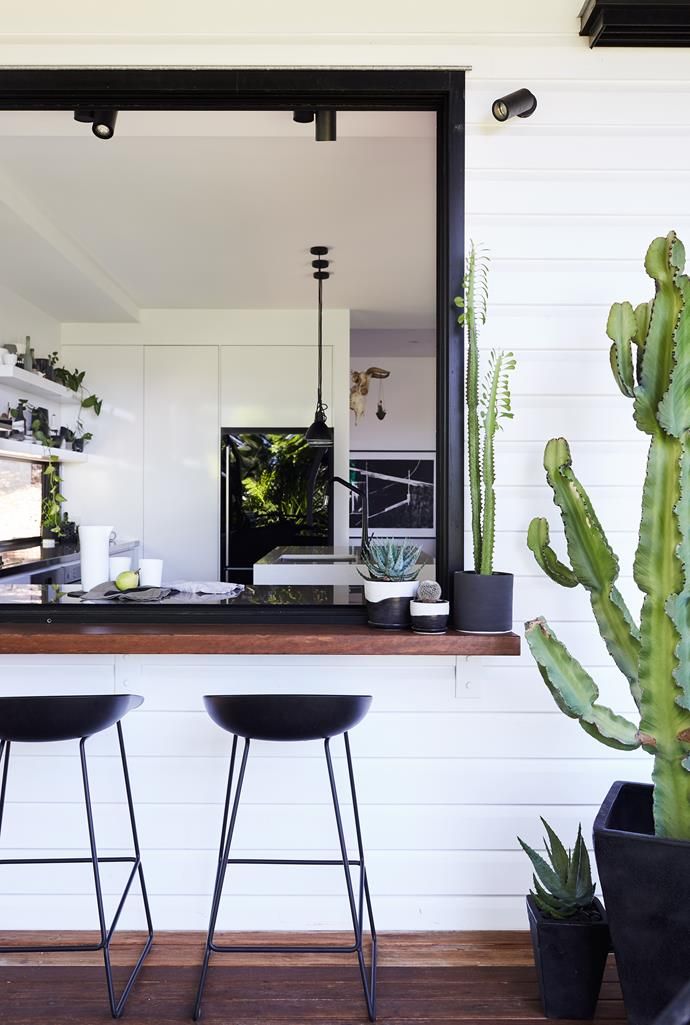
7. Assemble your dream team and go to tender
Armed with your technical drawings, get in touch with at least three contractors for quotes. Costs can vary widely, depending on how busy the builder is, what other work they have in your area, and how much they want to get the job.
It’s not always as straightforward as picking the middle-of-the-road quote either. Follow your instincts, as there also needs to be an element of chemistry between you – positive communication is essential.
Speaking of trades and your ‘dream team’, “who can I get to manage the project?” is a popular question. You can project manage yourself if you’re diligent and organised, and happy to arrange delivery of materials in line with the construction schedule. Or, architects and many construction companies offer a design and build service, while independent project managers and kitchen designers all have their specialisms and roles to play.
Ultimately, it’s up to you, your budget and the complexity of the project to determine who you engage.
If you do project manage yourself, I recommend a very good, detailed spreadsheet!
Although the existing kitchen was already on a split level, Martins Camisuli dug down further to create more height. The steps were also relocated to the right of the room for better access. Photography: Alex Macguire.8. Set a timeline
With your builder hired and a date set for starting on site, contact your kitchen designer to place your order and arrange a time for delivery. The average extension takes 12 to 14 weeks, but a large project can take anywhere up to six months or a year.
Similarly, the lead time for you cabinetry can be as long as 12 weeks. Some companies will require you to have an otherwise finished room – with flooring, electrics and plumbing in place – prior to installation, so it pays to plan ahead
and have a detailed timeline in place.
9. Blend old and new
No one wants a kitchen extension that doesn’t flow with the rest of the house, right? The aim: perfect flow.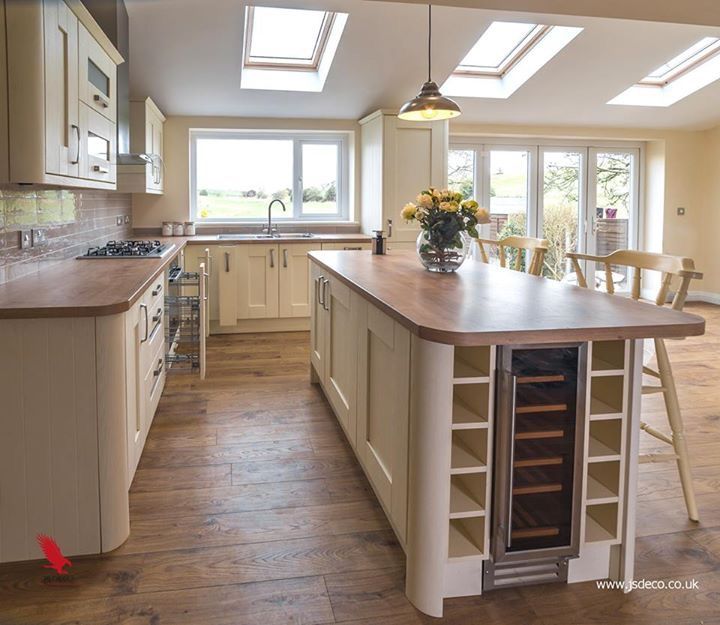
Keeping structural details such as the ceiling and floor heights the same between old and new rooms has a huge impact on integrating the new space, but there are other ways of blurring the boundaries too.
Replicate the style of skirting boards, internal doors, and window frames in the new space and keep to the same flooring and wall colour throughout for continuity.
Many kitchen companies are happy to design and install coordinating storage, fire surrounds, and media units to tie open-plan living areas together.
This 3 x 3m rear extension was covered under permitted development rules. The construction was overseen by Plus Rooms and extension designed by architects The Art of Building. Photography: Fine House Photography.10. Get ready for the project to begin
Ok, you’ve assembled your team, decided on the type of extension and figured out if it’s allowed by the council, plus you’ve got your dream kitchen planned and ordered. How do you keep it all running smoothly so the end result is perfect with a capital P?
Before it all kicks off, you’ll need to notify Building Control as well as your neighbours that work is about to commence (get in their good books).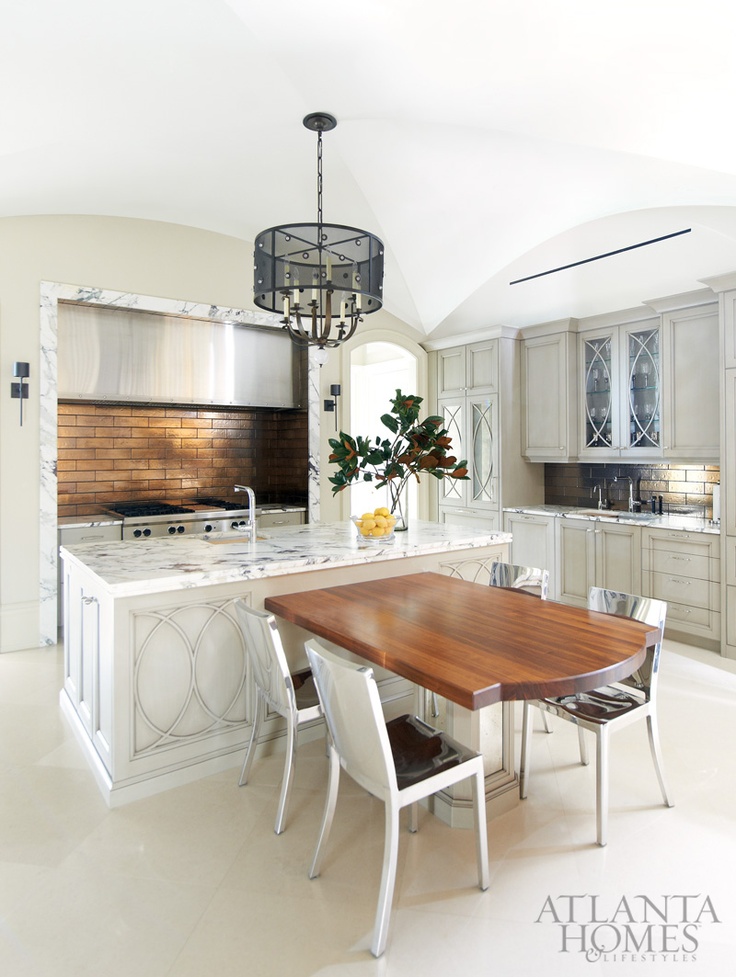
Make sure there’s good access and parking; a skip and portaloo are ordered if needed; you’ve set up a temporary kitchen; and arranged any storage hire or accommodation if you’re moving out.
Make sure you know where things such as the stop cock to turn off the water supply and the mains box for the electrics are.
Have all your belongings packed away before builders arrive – but leave the kettle out (!) – and consider how long you won’t have access to cooking and washing up facilities.
Don’t forget renovations insurance, too, to make sure you’ve covered.
And finally…stay one step ahead
While groundworks are taking place, make your second-fix decisions, which usually happen around week 12. Finalise your lighting plan and positioning of power points with both your builder and your kitchen designer, and start sourcing big-ticket items such as furniture, surfaces and flooring.
Windows and doors will be made to order, and companies tend not to manufacture them until the space is
measurable – so there’s often a lull while you wait for glazing to arrive.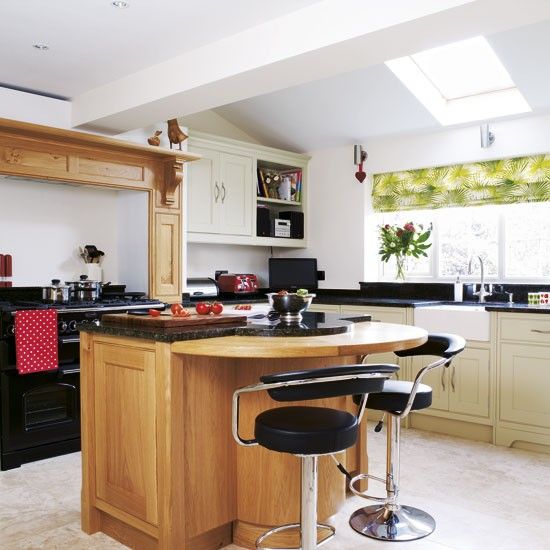
Agree a realistic fitting timescale with your installers and if you are using several different trades check when each will be needed during the process.
Planning a kitchen extension? Now all that’s left is to look at our gallery of 10 amazing kitchen extensions – inspiration awaits.
Featured image: An initial application for this wraparound kitchen extension was not approved by Lambeth council, as it would have changed the property too much. The original property was L-shaped and the extension plans would have completely changed its proportions. After the application was refused, the homeowners considered appealing at first – but it was never pursued as architects at The Art of Building came up with alternative option.
About Post Author
Kitchen extension to the house from a pro with 13 years of experience. Click!
Kitchen extension to the house.
What would your kitchen look like?
Of course, attached to the house?
Like this
And like this
And like that.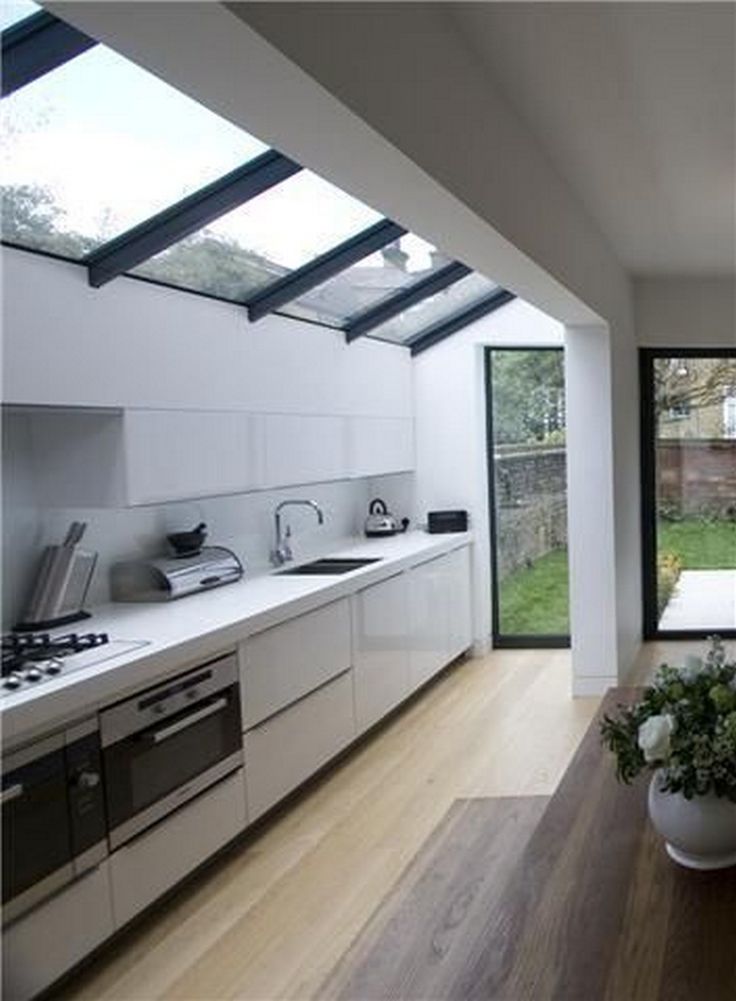
Various.
It can be summer or winter.
May be on the 1st floor or 2.
May be adjacent to the house. may be somewhat distant from it. nine0005
There are many options, but you have exactly 1 chance to make the extension successful.
These are not shoes / for women - boots that you buy once a season. This is an extension for 20-30, or even 50 years.
The choice is serious, so you need to think it over well, consult, draw in full growth and size. See what happens and then fix it if you don't like it.
You can even start with such a plan.
Yes, a process that lasts a month, or even several years. Many have an idea for years and then implement it. Or not. nine0005
To avoid mistakes, it is better to contact a specialist who knows a lot about extensions. It is in them. Building a house is easier. Renovating an apartment is generally easy. But the extension of the kitchen to the house is a completely different story.
Let's start it!
Tatyana Fedorovna lived and she wanted a spacious kitchen-living room in her house. Let it be an ordinary house 7x8 meters in 1.5 or 2 floors. Internet searches have borne fruit. She found several firms and teams. I called and made an appointment with some of them. nine0005
Someone has arrived, someone has not. And someone said that he would come only to conclude a contract for the project. What's the point of just dating. Here the next character of our story appears - Anton (yes, it's me).
Tatyana Fedorovna thought a little, looked at the work on the site and decided on the project. Do it anyway. Moreover, if the price does not suit you, then you can send it to other companies for miscalculations and find out the price there.
Yes, that's a good idea.
The meeting took about 2.5 hours. At this time, Anton took all the measurements, filled out a questionnaire of more than 50 questions, took photos and videos at home. nine0005
nine0005
Plans and facades are also sketched.
Liked it. The impression is positive. After a quick 20-30 minute meeting with other people, this person made an impression. If not a professional, then at least a person who understands something. It is a fact.
Then we made a project,
By the way, visualization.
Exactly what we wanted!
Also made a few edits along the way: changed the stairs, the entrance to the existing house and much more. 2 weeks flew by unnoticed, and then there was the main work, which no one canceled. nine0005
Adding a kitchen to the house - is not a quick process and the project must be drawn up correctly: all heights, all plans and stairs must be thoroughly thought out.
It's one thing to draw.
And another thing is to build what has been drawn and bring it to life.
And here, a common problem for designers and architects who are out of touch with construction is that the idea is unrealizable in practice.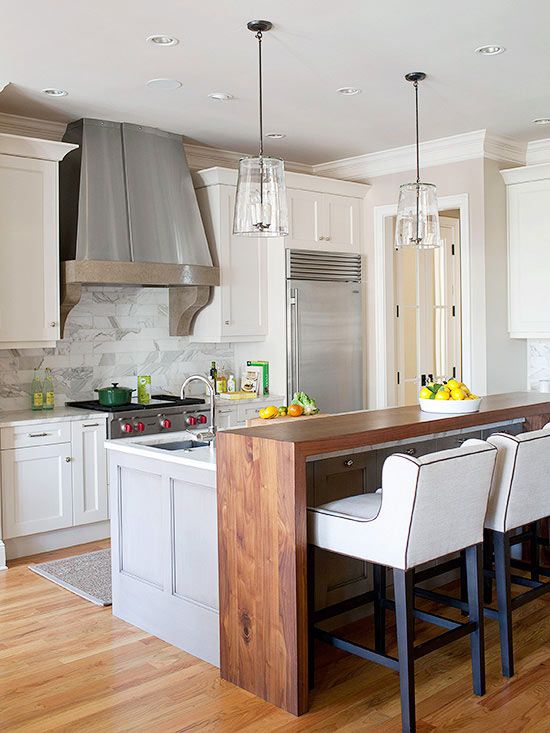
That is, they drew it, but it is not possible to do this. Or due to the lack of data materials. Or because of unaccounted for loads, or maybe there are simply no professionals to implement these works. nine0005
Therefore, the advice - this is already from Anton - do the project in an embrace with the builder. Because many people first look for an architect, thinking that he knows better how and what. He's also an architect. And they remember the builders after, when everything is ready. And it turns out that the overlaps do not correspond to the load. The roof slope should be more than 13 degrees for metal tiles, window openings are too large for such a roof area - they cannot be strengthened in accordance with SNiP, and so on and so forth.
The picture is beautiful, but the execution is impossible.
And it turns out that the project needs to be redone. A rare architect will do it for free. The answer will be simple: you wanted, I drew. Alterations cost some money and will be right in their own way.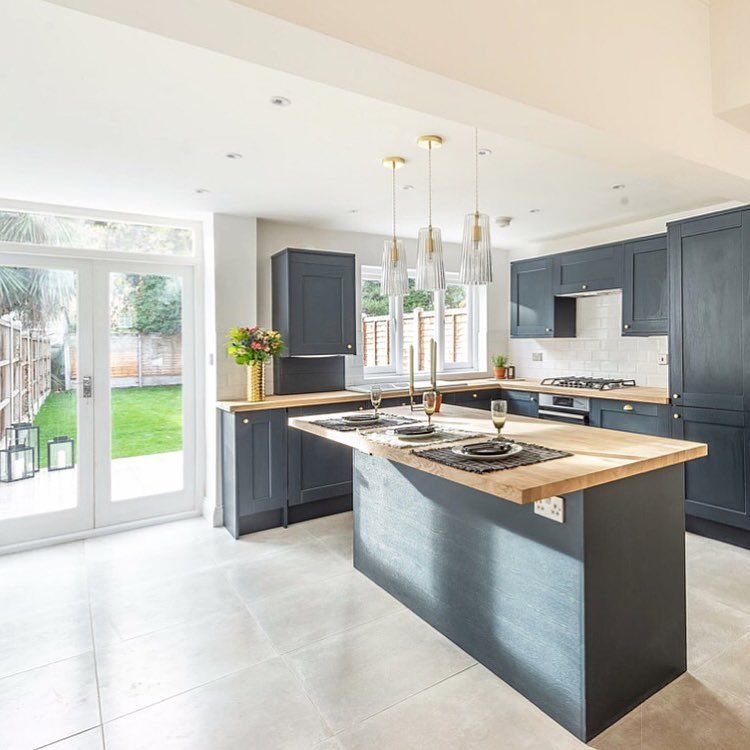 He won't build it. Its task is a beautiful picture that you like.
He won't build it. Its task is a beautiful picture that you like.
That's the point of such a waste of time and money when you can immediately apply to a company that already has its own architects. Who sit in 1 office (on the edge in the neighboring ones) with technical supervision, foreman or chief engineer. Whatever you call this position, this is a person who will be responsible specifically for the process of building your kitchen extensions to house .
I hope I explained clearly.
And now some beautiful pictures, how you can make it beautiful.
And it really can be built.
I wish you the same!
Do not forget that the extension can be either 1 floor or 2 floors. And you can also bury the cellar))
That's all, contact the professionals and may the force be with you))
You can start with the engineer's visit to the facility and the project. nine0005
Anton Shchelkov, Construction+.
Design of extensions to the house - Profremdom
The project of an extension to the house is a voluminous package of graphic, tabular, text documents.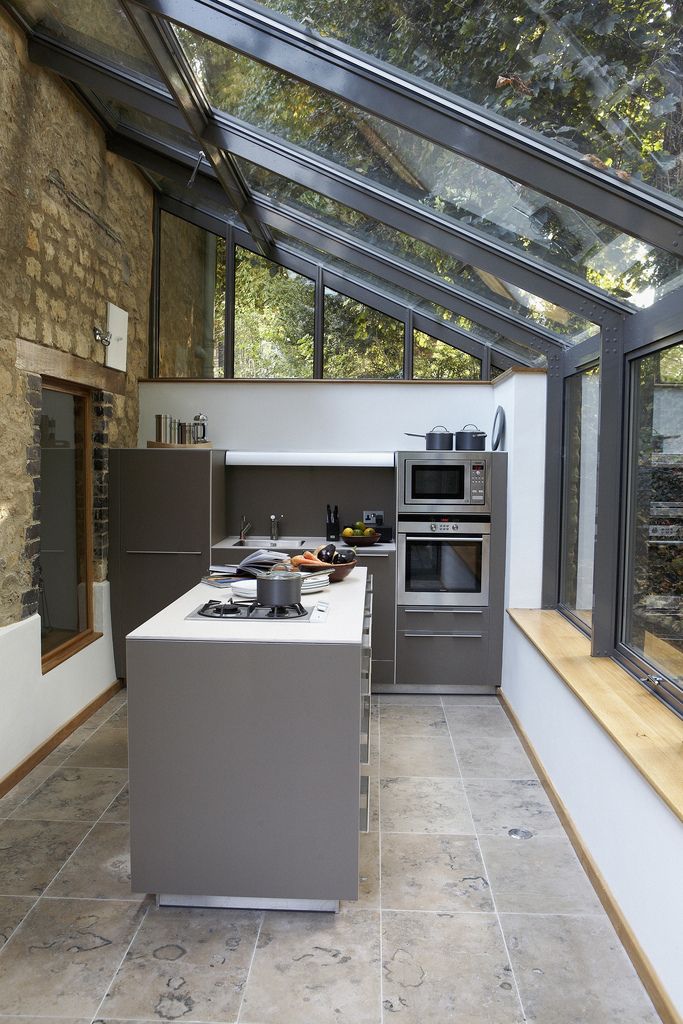 The purpose of developing working drawings and plans is to create a comfortable, convenient, durable, durable structure that will effectively perform its functions and look harmoniously next to the main, old house.
The purpose of developing working drawings and plans is to create a comfortable, convenient, durable, durable structure that will effectively perform its functions and look harmoniously next to the main, old house.
During the operation of a mansion, cottage, country house, situations often arise when it is necessary to expand the living space. The building can be supplemented with an utility block, a boiler room, a kitchen, a living room or a capital room with other functions, as well as a veranda or terrace. nine0005
In this article we will talk about the main types of extensions to the house, the features of their construction, give recommendations on the choice of building and finishing materials.
Purpose of the extension
The type of extension is determined on the basis of its functional purpose and the wishes of the owners of the house. The building can be used year-round or only in the warm season, on the basis of which the buildings are divided into open and closed.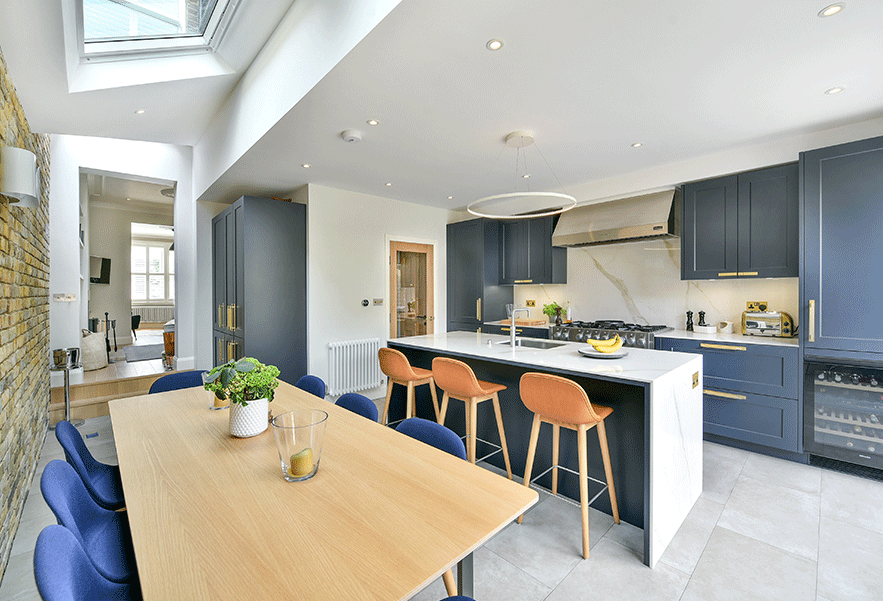
Summer outbuilding
Open or summer verandas, terraces. Their function is to organize a comfortable outdoor space for spending summer holidays. Such structures usually consist of the following structural elements:
- foundation;
- gender;
- perimeter fence;
- lightweight canopy made of polycarbonate or heavy tarpaulin
Base and floors are required, while fencing and awnings are optional. nine0005
Complete living quarters for year-round use
Closed buildings for year-round use are full-fledged quarters. The project of residential extensions provides for the arrangement of a reliable, durable foundation, walls, roof, high-quality insulation from all sides, and the supply of necessary communications.
Designing a new building
Goals for professionally designing an addition to an old house:
- achievement of external harmony between the main building and the attached premises.
 The architectural style of the house and extension should be the same. The same or similar building and finishing materials are used;
The architectural style of the house and extension should be the same. The same or similar building and finishing materials are used; - obtaining a functional building in accordance with its purpose. Open terraces and verandas are a well-equipped area for leisure activities. In a residential area for year-round use, it is necessary to provide for the placement of heating and lighting devices. These features are reflected in the drawings and plans. nine0150
The kitchen or bathroom needs engineering systems (sewage, water supply). For the winter garden, the project determines the types of window and door blocks with a large glazing area to provide full-fledged natural light at any time of the year
In order for the building to serve for many years, at the stage of developing the project of extensions to the house, miscalculations are made to ensure the strength of all components of the structure. Factors such as:
9 must be taken into account0148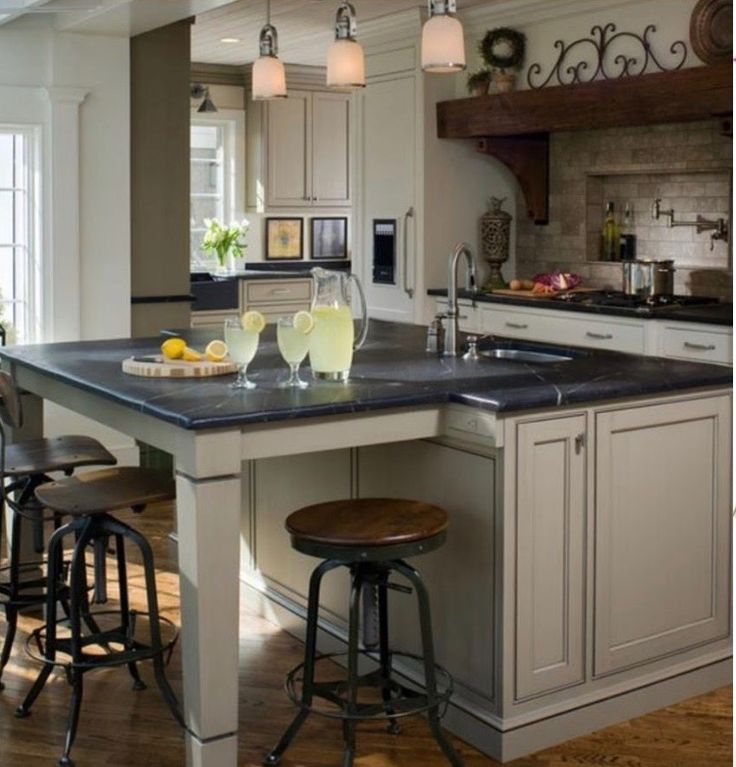
Base design
The design process begins with a site visit and a study of the base under the main building. For capital buildings, the same type of foundation is usually chosen, which is laid under the old house. nine0005
On moving soils, with a high occurrence of groundwater, in the event of significant elevation differences in the area, a pile foundation is installed. For it, metal piles are screwed in or monolithic pillars are erected from reinforcement and concrete mortar. Such a foundation can withstand well one-story buildings of light weight, built on a frame filled with sandwich panels or erected from wood.
For brick buildings, a more powerful foundation is needed - tape with a large depth or monolithic, capable of withstanding a heavy brick structure. nine0005
If the extension is planned to be used only during the warm period, as a place for recreation, then the project provides for a base on low posts made of blocks or bricks, which does not require significant deepening into the soil.
To ensure that the floor on the veranda or terrace does not deteriorate from excess moisture, waterproofing is carried out from the foundation. For arranging the floor, it is recommended to select boards impregnated with special protective compounds that increase resistance to moisture. nine0005
In the projects of extensions to the house, the junctions of the foundation of the main building and the completed structure are indicated. The fastening of the lower crown is recommended to be carried out according to the tenon-groove principle. This creates conditions for a slight mobility of the lower rims of the structure, which makes it possible to avoid deformation of the structure during the period of shrinkage, with seasonal temperature fluctuations.
Wall design
When building extensions to the main building, the same wall materials are usually used. This creates an attractive appearance of the structure, a house with an attached structure looks harmonious.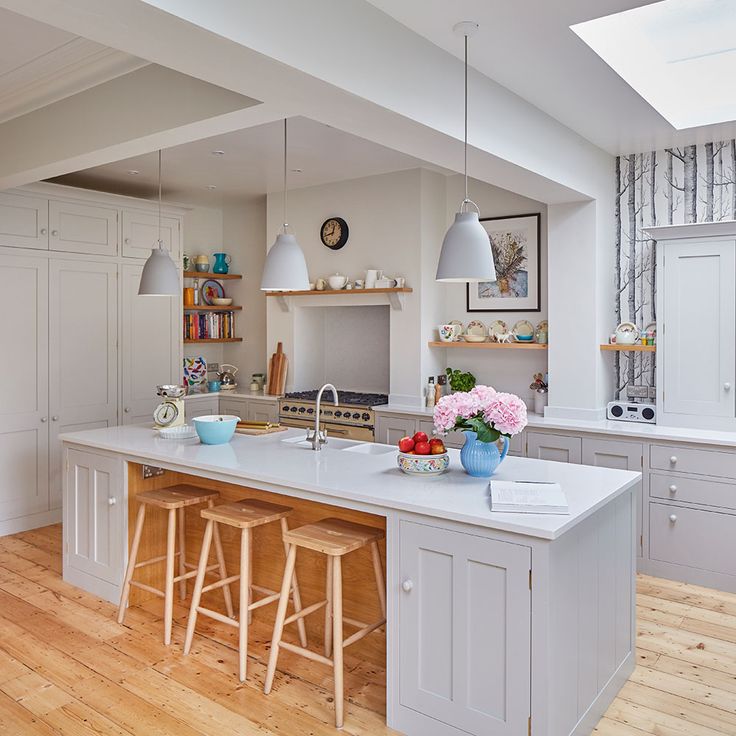 nine0005
nine0005
There are situations when, at the request of the owner and in accordance with the design intent, the extension can be built from another material. A closed, insulated veranda, a bathhouse or a kitchen made of timber, a boiler room made of gas blocks are sometimes attached to a brick house.
The choice of material for construction is carried out during design in order to calculate the weight of the structure, determine the type of foundation for it, and the type of roof.
The main materials for the construction of walls of extensions are:
- brick;
- foam blocks;
- aerated concrete;
- wooden beam;
- sandwich panels.
Roof design
Two types of roof are installed for the summer extension:
- stationary. Along the perimeter of the site, metal pipes or wooden beams are dug in, on which polycarbonate, profiled sheets are mounted;
- temporary. A canopy made of fabric, garden mesh is installed
For a year-round extension, a reliable roof is being installed from the same material that covers the roof of the house. In accordance with the design drawings, the roof is sloping away from the house to allow water to drain. To prevent heat loss and water leakage through the roof, waterproofing and insulation are made.
In accordance with the design drawings, the roof is sloping away from the house to allow water to drain. To prevent heat loss and water leakage through the roof, waterproofing and insulation are made.
Projects of buildings from various materials
Frame extension
The lightest in weight, simple in construction, less costly is the structure built using frame technology. It does not lay a powerful deep foundation. A frame made of wooden bars is mounted on a strip or column foundation, between which insulated sip panels are installed. nine0005
A feature of the frame construction - it is not recommended to choose heavy materials for roof covering (metal tiles, ceramic tiles), since the frame may not withstand such a load.
Advantages and disadvantages of foam blocks and aerated concrete
Foam blocks and gas blocks are quite light materials. The construction of walls from foam blocks and aerated concrete takes place quickly, without the involvement of special equipment, and requires relatively small investments.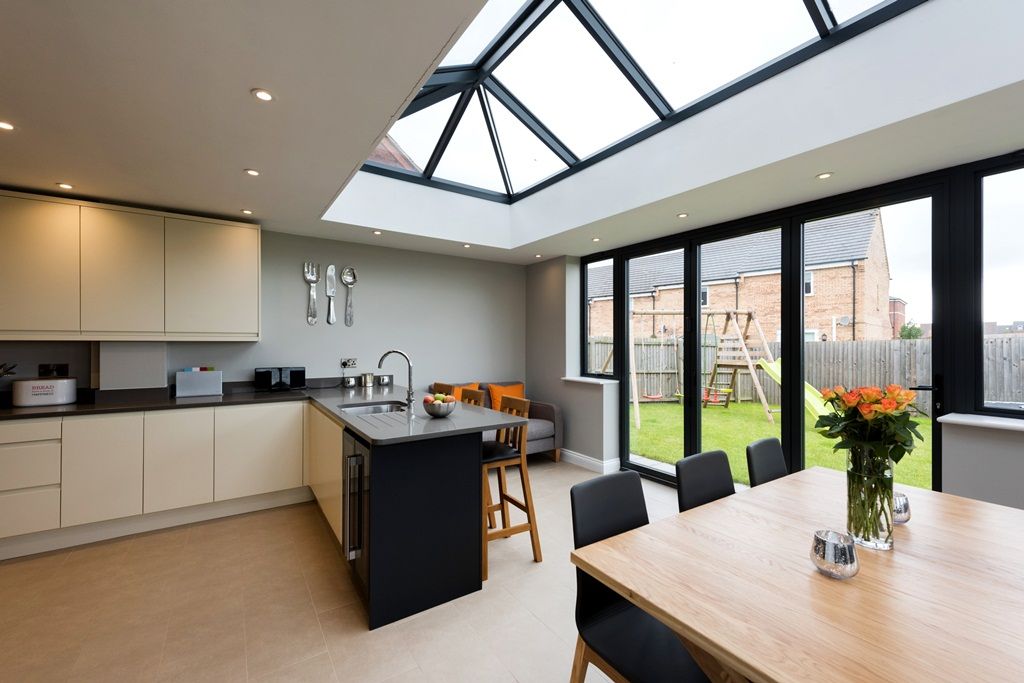 Walls made of foam blocks allow air to pass through, retain heat well. nine0005
Walls made of foam blocks allow air to pass through, retain heat well. nine0005
Owners of aerated concrete and aerated concrete structures should be prepared for the appearance of small cracks on the walls during operation. Therefore, the working draft necessarily provides for finishing work on the outside of foam concrete and gas blocks, insulation and decoration inside the room.
Timber outbuildings
Premises made of wooden beams are often attached to country houses, country cottages and mansions. The choice of material is due to its environmental safety, attractive appearance, strength and durability. The advantage of a wooden extension is also the absence of the need to carry out finishing work, both indoors and outdoors. nine0005
Brick extension
Strength, reliability, durability are the main characteristics of a brick extension. The features include the weight of the structure, requiring the construction of a powerful foundation.